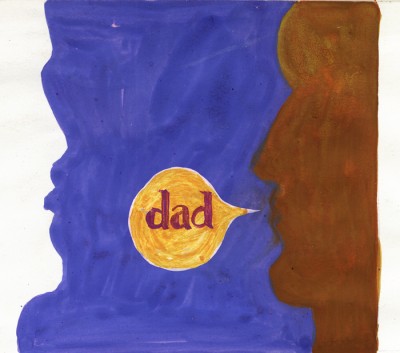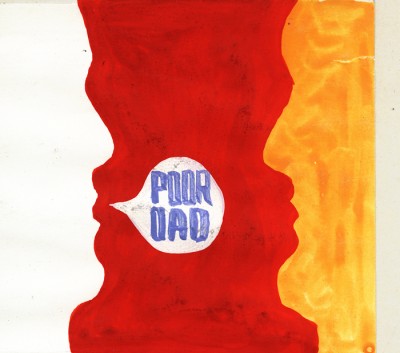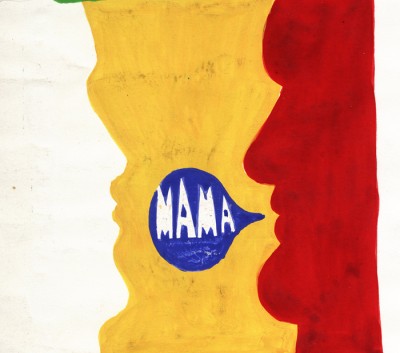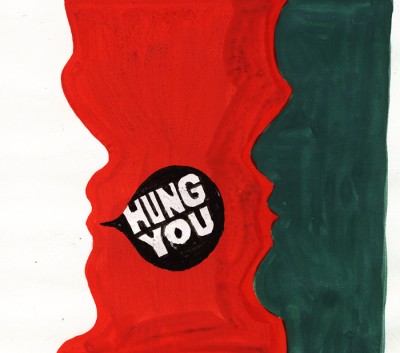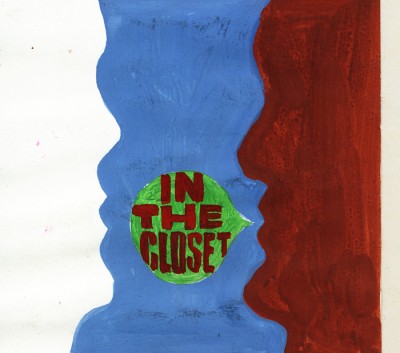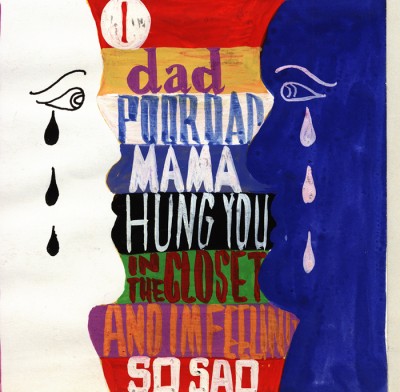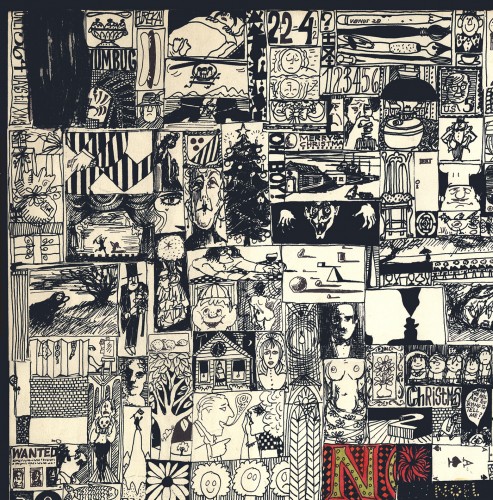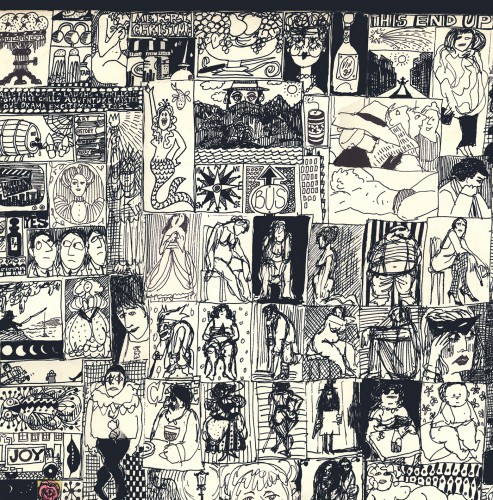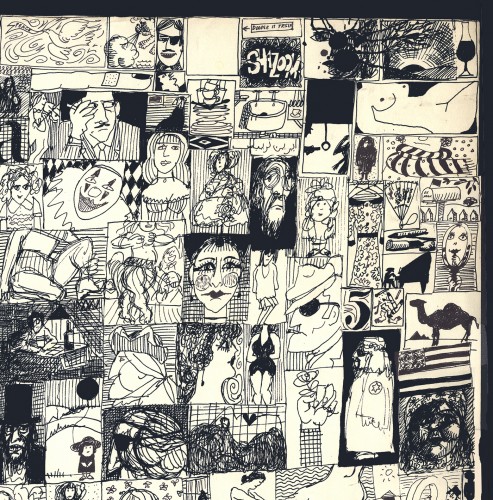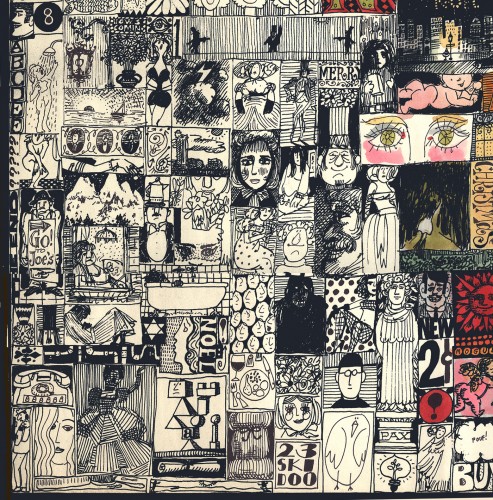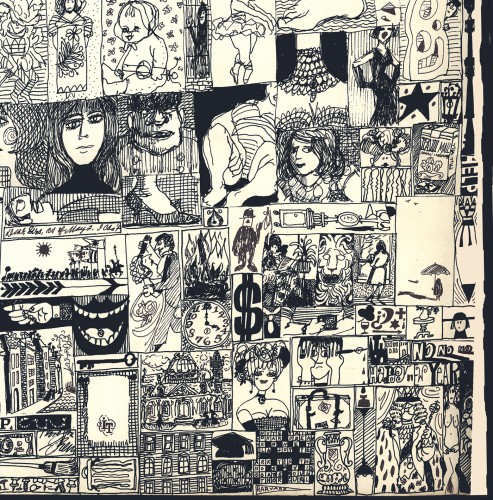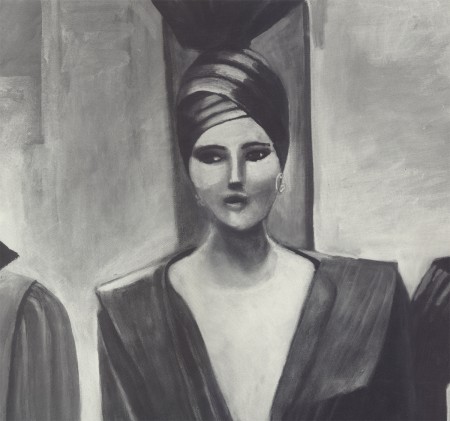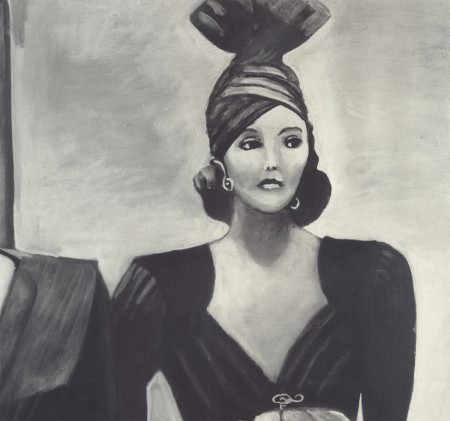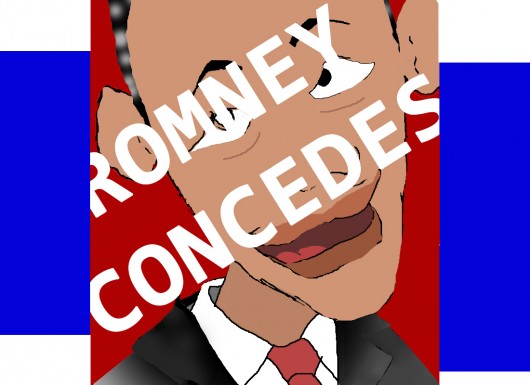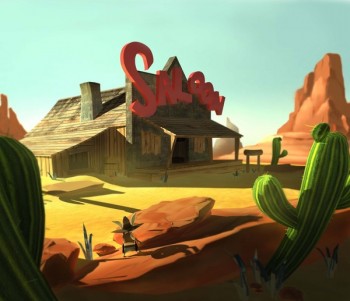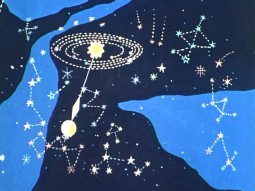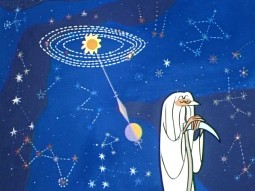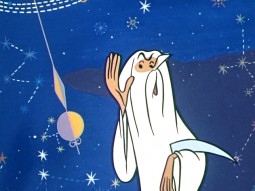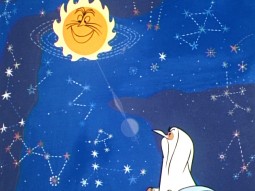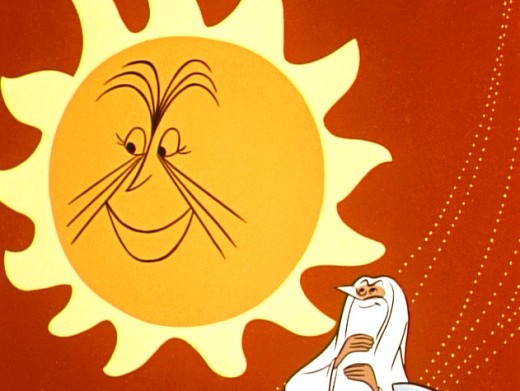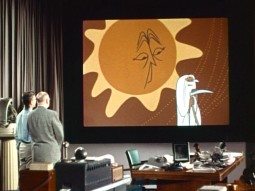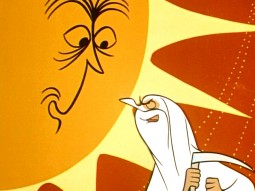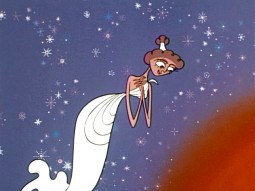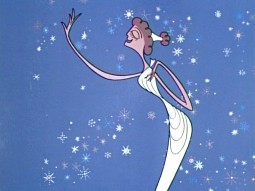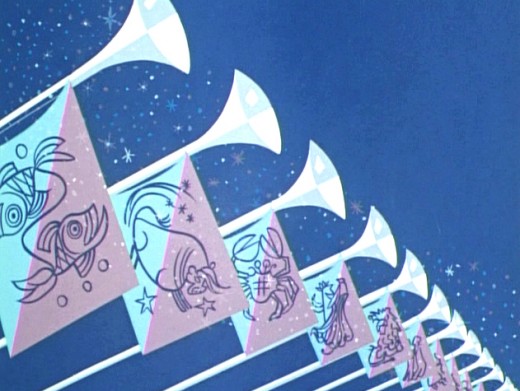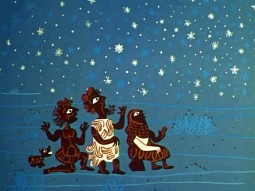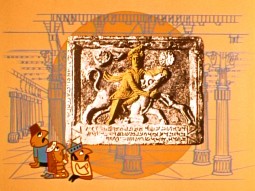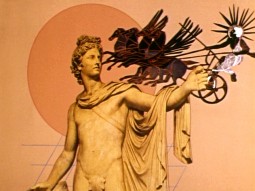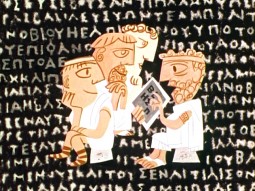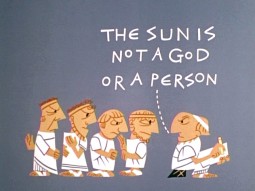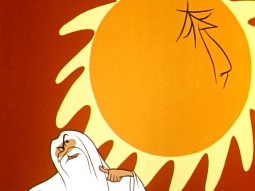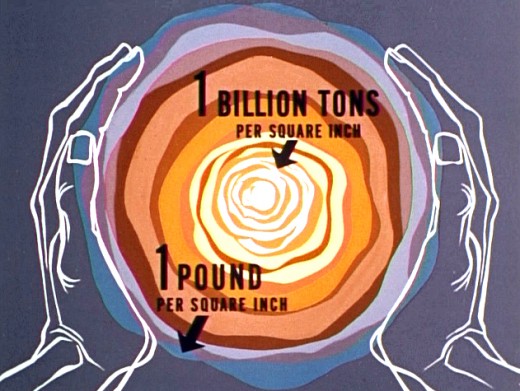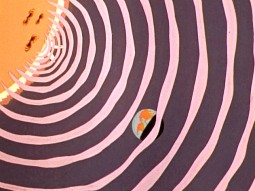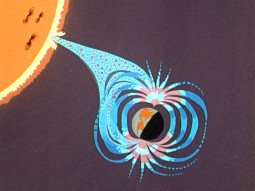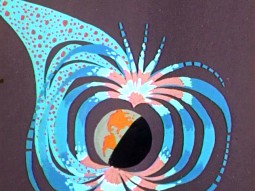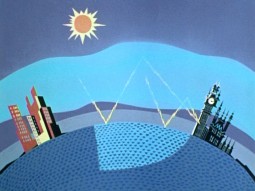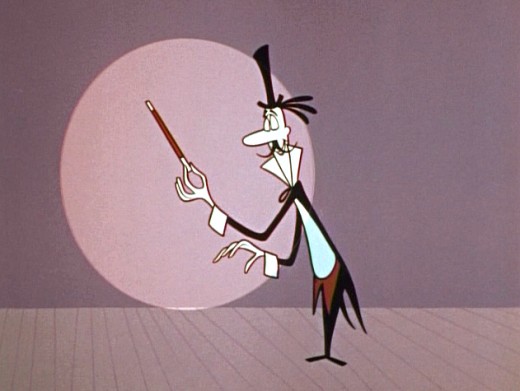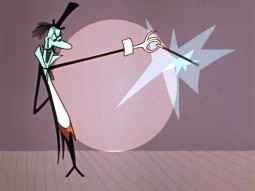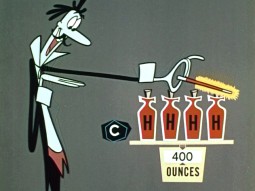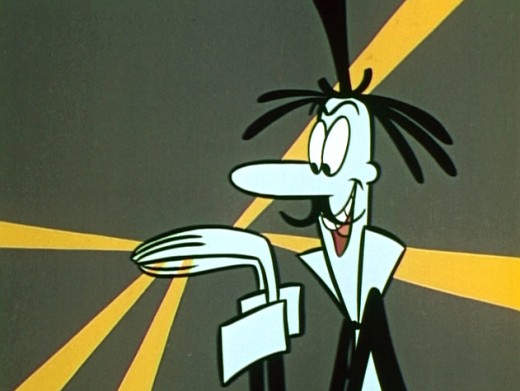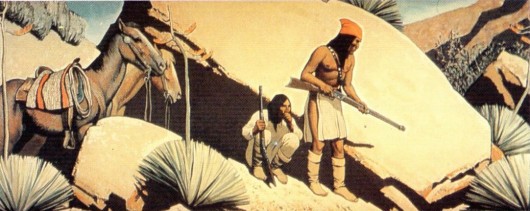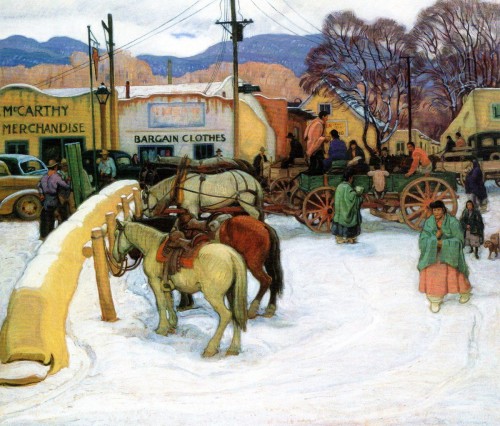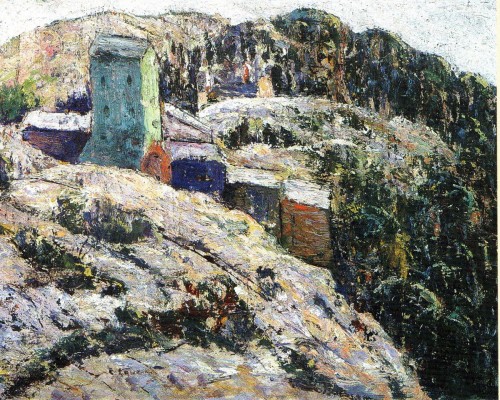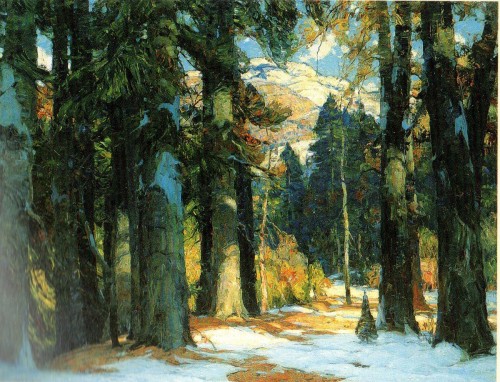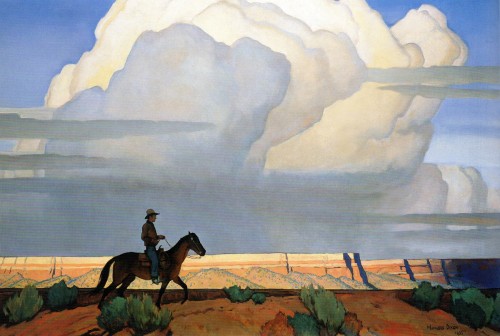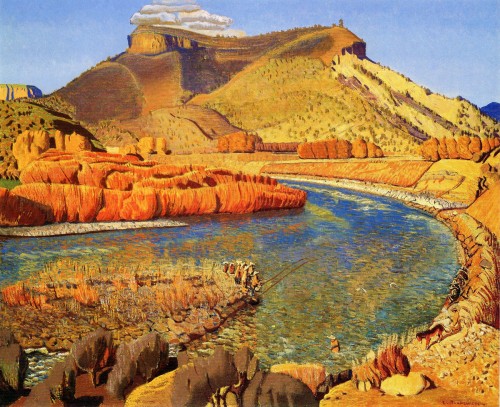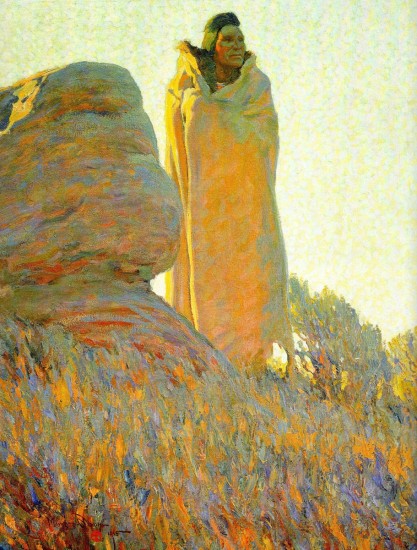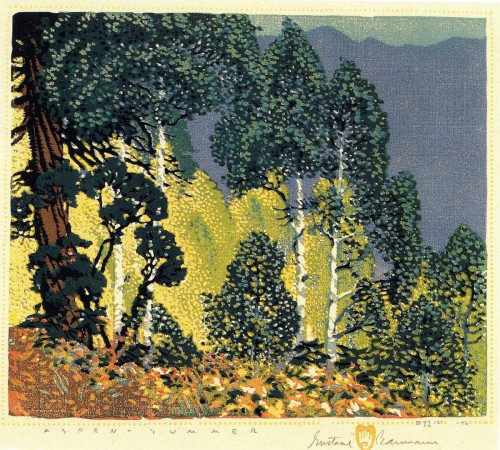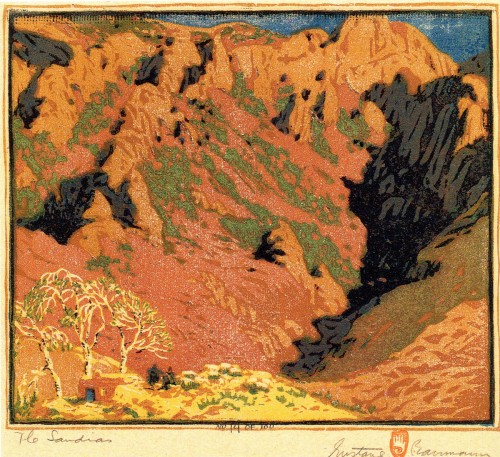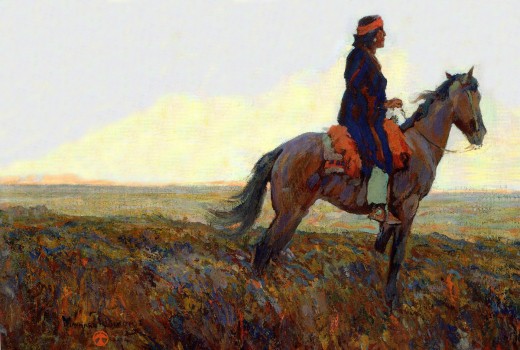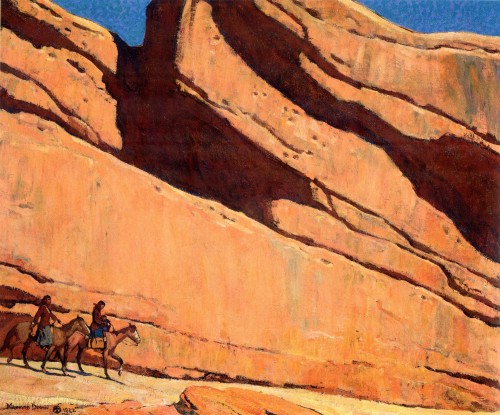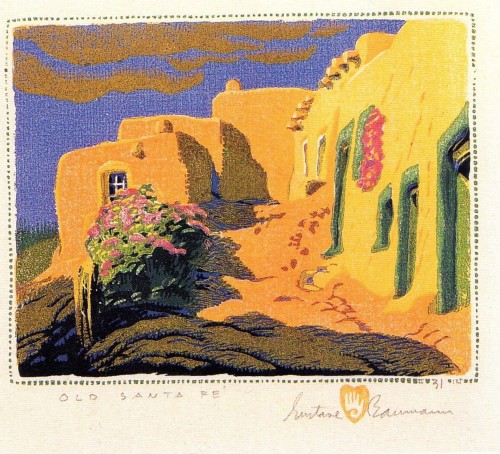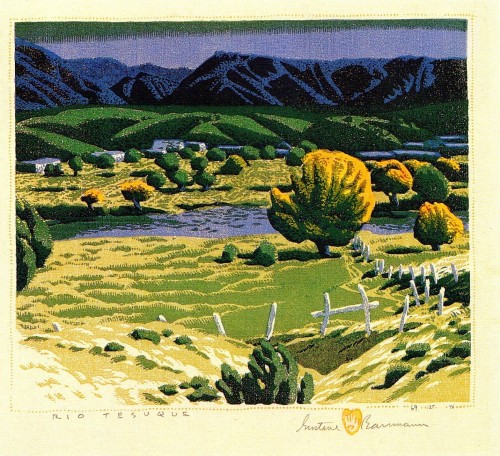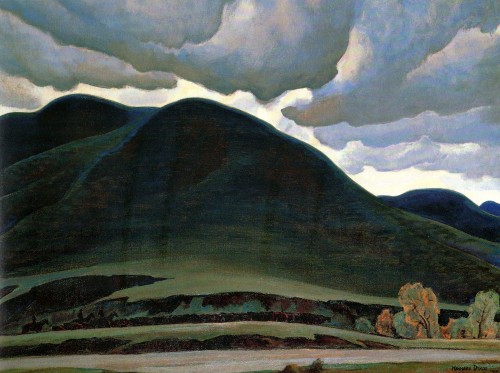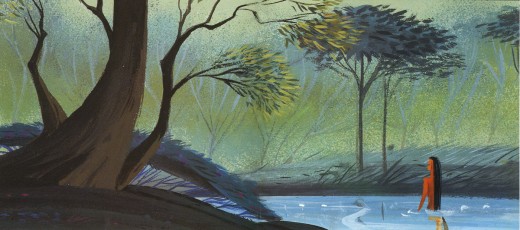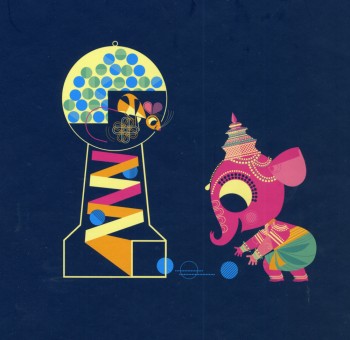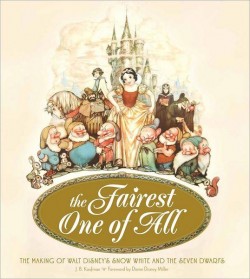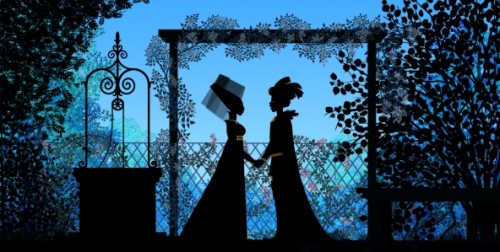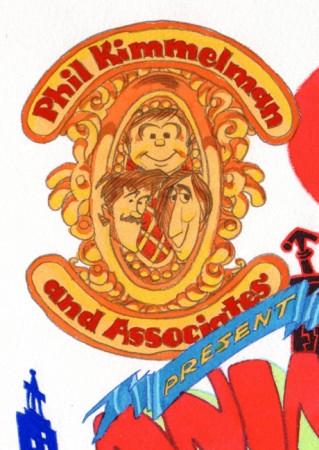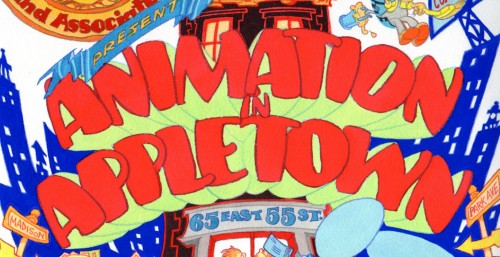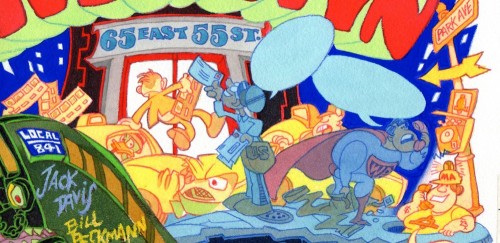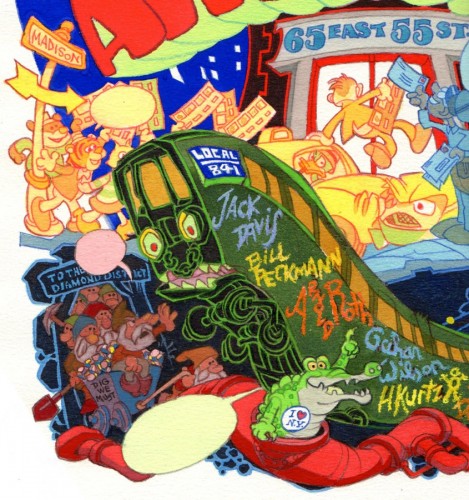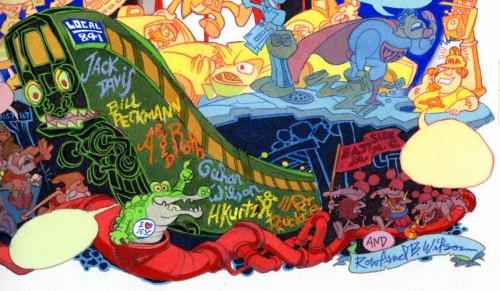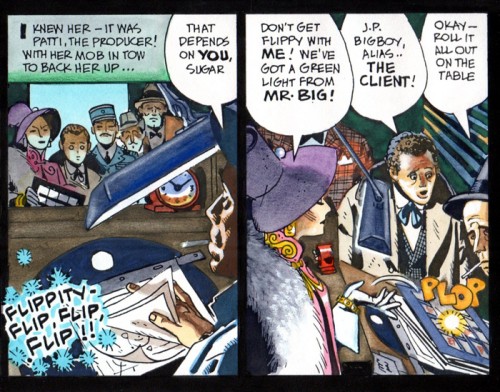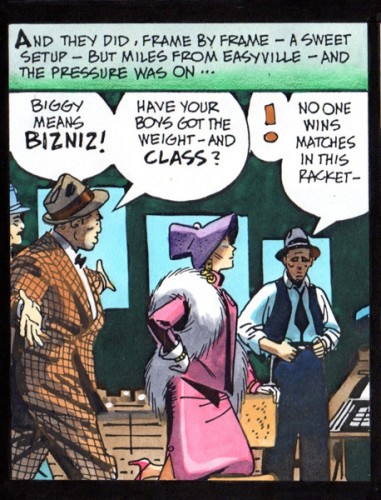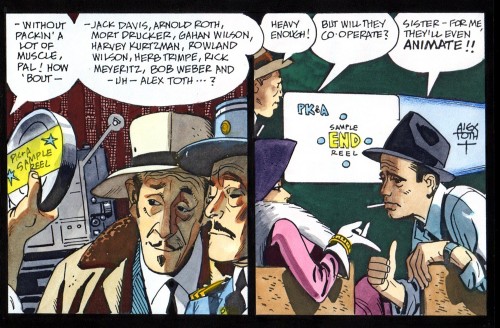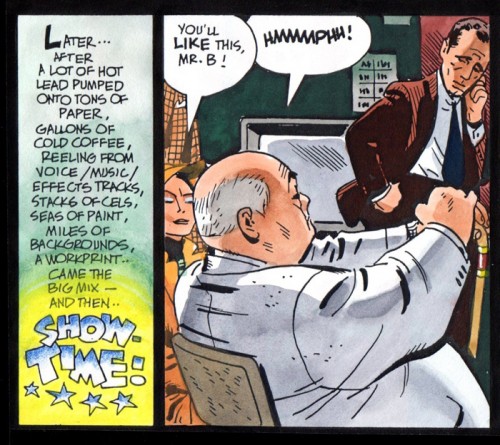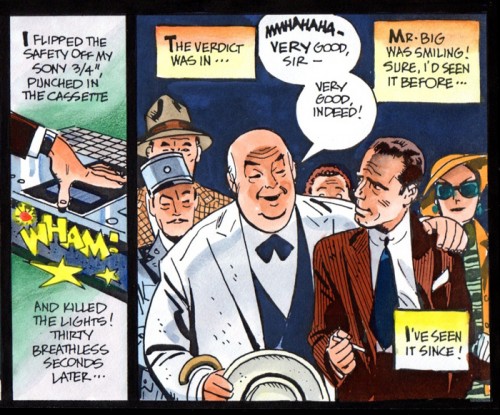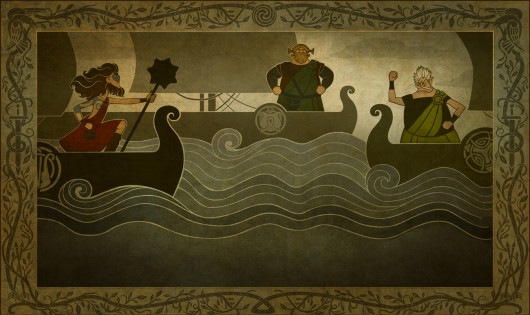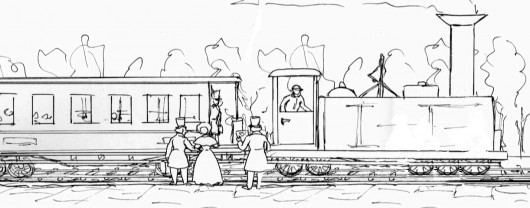Category ArchiveDaily post
Daily post 14 Nov 2012 08:30 am
Mogubgub 3
- Fred Mogubgub did a lot of varied work. Here are three pieces which were done large. In all three cases I’m posting them in the full format and then breaking them up to allow you to see them in a larger size.
Here is what, undoubtedly, was a storyboard opening for the Broadway show, Oh Dad Poor Dad Mama’s Hung You In the Closet and I’m Feeling So Sad, Arthur Kopit‘s furst play; it opened on Broadway in 1963 for 47 performances. The show was directed by Jerome Robbins, and the animated prologue was done by Fred Mogubgub and Pablo Ferro. This is only one of three animated films done for the Broadway stage. This piece accompanied music written by Robert Prince. (The other animated films were both done/directed by me for Woman of the Year, a number of segments that incorporated dialogue as well as a musical duets between a character and a stage actor. The third film was an animated overture done for Meet Me In St. Louis, animated archival-looking postcards, animated. The final one turned into a live setting of the town ice skating.)
This is Oh Dad, Poor Dad, a full image of the board:
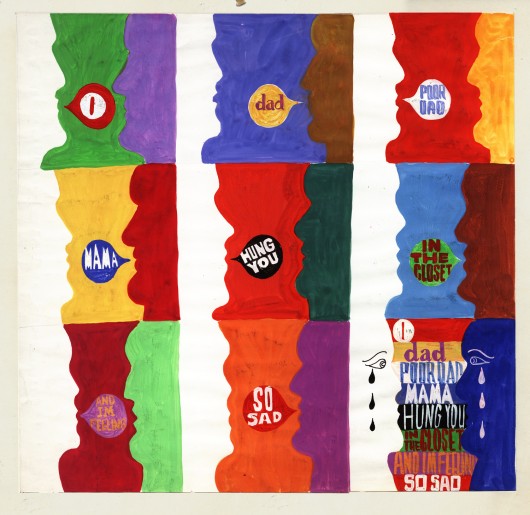
The final art used flat colors.
This is the same thing broken down into panels
to allow you to see them in a larger format.
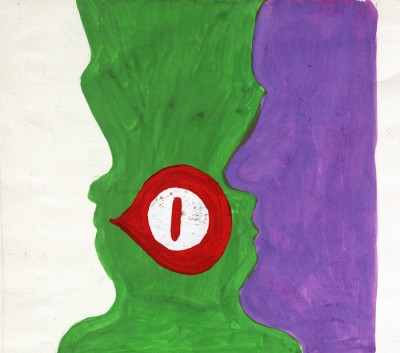 1
1(Click any image to see them at a larger size.)
__________________
To follow that famous piece, there is a Christmas card, or it seems to be a Christmas card. The thing is so large it took a lot of work in photoshop to put it together. The whole is 30″ x 24. I’m posting it twice. Once full size, then in pieces so you can see/read it.
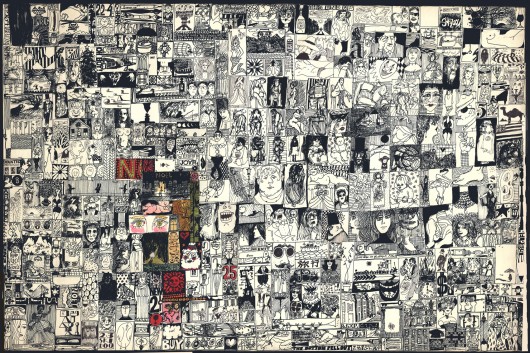
The full thing
(Click any image to enlarge.)
__________________- Another large piece by Fred Mogubgub is a painting from which he created 500 photographic prints. It was a major part of an exhibit Fred had, and the prints were sold by the gallery. As with the other large pieces, I’m posting it whole and then again, in parts.
The painting is entitled, “Paris Streets.”
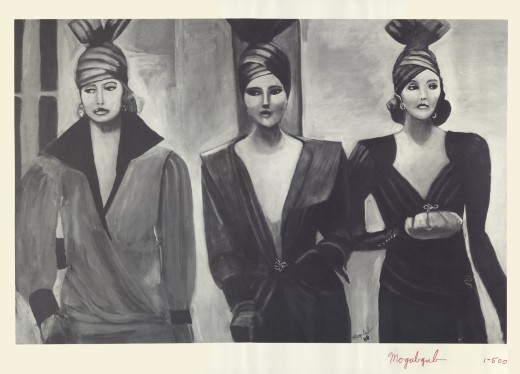
The full image
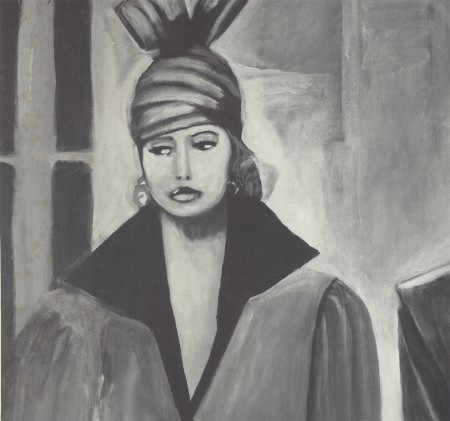 1
1
The first woman on the left.
.
__________________
.

An ad for the company drawn by Irene Certas.
Very interesting. She was a brilliant checker, inker,
production coordinator who, for years, managed a
number of small studios including J.J.Sedelmaier‘s.
She is also Janet Scagnelli’s sister.
Obviously, brilliance runs in that family.
Daily post 07 Nov 2012 02:07 am
Winning
Commentary &Daily post 03 Nov 2012 07:35 am
A Dully Exciting Week
It’s been a long week. The events of my week probably aren’t going to be too interesting to many of you, but it’ll be cathartic for me to write, so I will.
Monday brought the threat of a hurricane. I remember thinking that “Sandy” was not the best name for a hurricane; naturally, it would turn out to be one of the nastiest in my lifetime. Once again, as they had done with “Irene” they told us to prepare by buying duct tape, batteries and water. With “Irene” it was a waste of time;with “Sandy” it was a necessity. Actually, the best buy for us was one Heidi had done for “Irene.” All of the stores had sold out of flashlights, until she found one in a local hardware store. This was a huge thing that actually worked as one or broke into three separate flashlights. This item became a lifesaver a year later during the “Sandy” debacle.
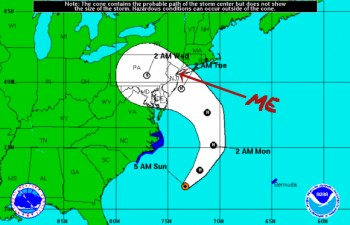 Monday night there was a robo-call from Con Edison. They threatened to possibly turn off the electricity as a precaution to preserve the system. It would enable them to start the system up all the more expeditiously when they could. The weather map they were showing on TV had the cone of the hurricane’s left turn, off the Atlantic and onto a land mass, happening south of NY near the Jersey Shore.
Monday night there was a robo-call from Con Edison. They threatened to possibly turn off the electricity as a precaution to preserve the system. It would enable them to start the system up all the more expeditiously when they could. The weather map they were showing on TV had the cone of the hurricane’s left turn, off the Atlantic and onto a land mass, happening south of NY near the Jersey Shore.
I’d been engrossed in my latest enthusiasm, the Presidential election. Things were close. Obama was leading in a couple of the key swing states by one or two – the lights went out. Everything. Silence.
Heidi pulled out our tri-part flashlight and we broke into three parts and moved it around the house as we lit candles. She had really prepared with books of matches and tiny tea candles. We placed enough around to keep a semblance of life alive visually in the apartment.
 - Tuesday early morning brought the loudest noises. Not much rain but a lot of wind. We soon came to realize that the no-electricity also meant no heat. It wasn’t freezing outside, but overnight it felt as though it were freezing inside. For the rest of the week we had to bundle under quilts and blankets wearing layers of sweatshirts. The cats were confused and visibly cold. They went into winter mode, sleeping on their paws on beds and blankets and near any heat they could find.
- Tuesday early morning brought the loudest noises. Not much rain but a lot of wind. We soon came to realize that the no-electricity also meant no heat. It wasn’t freezing outside, but overnight it felt as though it were freezing inside. For the rest of the week we had to bundle under quilts and blankets wearing layers of sweatshirts. The cats were confused and visibly cold. They went into winter mode, sleeping on their paws on beds and blankets and near any heat they could find.
I got up every morning to light the stove. It’s a gas stove but has an electric starter that lights the pilot for you. I had to get in there and light the pilot every time I wanted to get it going. I lit it and figured a way to manipulate the oven door into the open position so that heat would invade the apartment, raising the room temperature by 10°. Since I no longer had a toaster, I could also use the lit oven to toast my english muffin in the morning.
No internet. This is a problem. No Splog. I had prepared a couple, and they were ready to be posted. By calling my sister, who had power, I was able to arrange to post the next two blog posts. Anything beyond that, and I’d have to write additional material. Not easy without access to a computer. Lack of a computer was more serious for Heidi. She lived off her email conversations with the different theatrical groups she works for. They actually hire via email, and things were already sketchy for a number of her assignments in the upcoming week. But she needed to get to the email to find out. If school was cancelled for the kids in any given day, Heidi lost out on a couple of jobs and hundreds of dollars. They meted out the information slowly over the course of the week. She kept preparing for classes in case, and they were ultimately all cancelled all week long.
 We went out to see what it was like on the street. Our neighborhood was dead. ALL of the stores were closed (they couldn’t even operate their cash registers without electricity.) We wouldn’t be able to do laundry until the power came back. We walked the ten blocks in a nasty cold windy rain to the first open store, a Duane Reade pharmacy. I went to the rear near the pharmacy (which was closed) and sat in one of the chairs provided for those waiting for prescriptions. Heidi shopped to see if we needed anything. Ultimately, we left watching a couple of elderly women blocking the cashier aisle as they used the electric outlet to recharge their cel phones. The very young cashiers – maybe they were 16 – didn’t care. None of the Starbucks stores we saw were open that day. We’d thought we could always go to Starbucks to recharge Heidi’s cel. (I still don’t have one. Talk about being out of it.)
We went out to see what it was like on the street. Our neighborhood was dead. ALL of the stores were closed (they couldn’t even operate their cash registers without electricity.) We wouldn’t be able to do laundry until the power came back. We walked the ten blocks in a nasty cold windy rain to the first open store, a Duane Reade pharmacy. I went to the rear near the pharmacy (which was closed) and sat in one of the chairs provided for those waiting for prescriptions. Heidi shopped to see if we needed anything. Ultimately, we left watching a couple of elderly women blocking the cashier aisle as they used the electric outlet to recharge their cel phones. The very young cashiers – maybe they were 16 – didn’t care. None of the Starbucks stores we saw were open that day. We’d thought we could always go to Starbucks to recharge Heidi’s cel. (I still don’t have one. Talk about being out of it.)
There was an event on Tuesday evening. A film was to be screened at MoMA. A few phone calls and I wasn’t able to find out whether the event was still on. We’d need to somehow be entertained in the evening. Getting out of the dark house. The neighborhood was also dark. Couldn’t see the hand in front of your face on the sidewalk. One of those flashlights was helpful to carry with you. It took until Wednesday for officials to realize they had to position a cop with flares at all the corners to direct traffic and avoid accidents. It was really dangerous for the pedestrians trying to get across the black streets. When I couldn’t get through via phone to MoMA, I decided to give up on a 20 block walk when I wasn’t sure if the film would be screened. We stayed in.
I called John Canemaker that evening. We had phones, as a matter of fact most people had phones. However, if the phones depended on electricity, they wouldn’t work. Fortunately, we had an old phone with a dial on it – no buttons to press – you turn the dial for each number. That worked. He had phones, heat, electricity and the internet. He invited us up to use his computer to check our emails.
Wednesday we had a game plan. I aimed for John’s apartment about 45 blocks away. Some buses were in operation for the first time. The rides were gratis, thanks to the City. However, there were fifty people waiting at every bus stop, and any bus that arrived was packed. Where there’s a will, there’s a way, and we got on a bus. It took about 30 minutes to go from 30th St to 42nd St. Heidi got off to go to the office at the New Victory Theater. They told her she could pick up some material she needed and she could use their computers if she needed one. She realized it’d take forever to get to 70th St to see John and Joe, and she had to do a bit of work and still get home in time to meet me to head up to SONY to see a film that evening. 6:00 cocktail/6:30 screening of Amour.
It took another hour for me to get to John’s apartment. Slow going. I could’ve walked there quicker. We had a nice, friendly chat. I posted something for the blog that said I’d have to freeze the thing until power returned, and I went through some of my email. John & Joe were taking in some friends who were lacking all utilities and couldn’t even shower. Nice of them; as John said, “That’s what friends do.”
It took forever to get to SONY on 55th Street. The bus crawled. We ditched it at 42nd street and walked the rest of the way. 1/3 the trip by bus = 45 minutes. 2/3 of the trip on foot = 15 minutes. We sat with Josh Mostel and laughed. He pointed out that there was no difference for him on the Upper West Side. With all his windows closed, he wouldn’t have known that a disaster had struck had he not seen the TV reports. Rain was light despite the fact that waves of water sunk the lower tip of Manhattan under the Hudson. I always knew how lucky we were to be only short of electricity. Here I was at a free movie with a cocktail and no thoughts whatsoever of complaining about my “plight”.
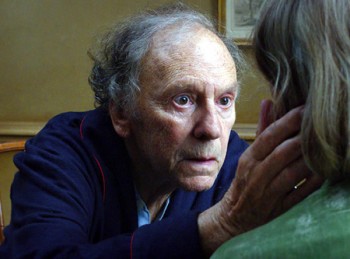 Amour was one of the best films of the year. It was directed by the German film maker, Michael Haneke, who had been nominated last year for The White Ribbon. His style is stark and direct and purposefully staid. Amour is the better of the two films, in my opinion, and the reason is Jean-Louis Trintignant, who gives one of his best performances and certainly the best performance of the year. He is brilliant and he is the reason not only to see the film but for the film’s existence. It is amazing in its stillness. Emmanuelle Riva is also excellent as his wife, heading full into a steady downfall via Alzheimer’s disease. I want to see the movie again, certainly. I’ve thought about it the rest of the week.
Amour was one of the best films of the year. It was directed by the German film maker, Michael Haneke, who had been nominated last year for The White Ribbon. His style is stark and direct and purposefully staid. Amour is the better of the two films, in my opinion, and the reason is Jean-Louis Trintignant, who gives one of his best performances and certainly the best performance of the year. He is brilliant and he is the reason not only to see the film but for the film’s existence. It is amazing in its stillness. Emmanuelle Riva is also excellent as his wife, heading full into a steady downfall via Alzheimer’s disease. I want to see the movie again, certainly. I’ve thought about it the rest of the week.
Heidi and I walked home in the dark. We had a lot to talk about.
Thursday was more of the same. I began by sketching for an animatic I’m trying to put together to show HBO. I’m trying to sell them on an idea about chemotherapy – not Cancer, but chemotherapy. It’ll be a documentary about some people who were touched by the “cure”. I’m sure HBO won’t buy it, but I’ve got to present it. I’ve recorded some of the voice work and am offering a couple of sections via animatic so they’ll know what I want to do. I’ve decided to sketch it out with pen and pencil and not draw it on computer. Who knows if that’ll mean anything once I’m into it.
I had a few chores to do; Heidi wanted to get back to the New Victory Theater. There were a couple of films scheduled to play at the Academy theater. I’d seen the second but thought I’d go to the documentary screening first. It was something about the decline of Detroit, and sounded as though it might be interesting. I phoned Candy Kugel and talked her into going. It’d be nice to say hi. Heidi couldn’t make it. She’d be working until 7:30. The plan was for us to meet after the film and her job; then we’d go to a diner near the theater and come home from there. It’d keep us out of the black apartment until it we had to.
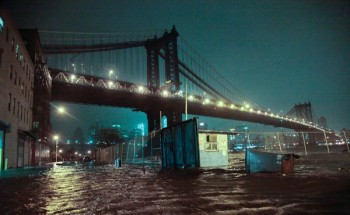 I left the apartment at 5:00 to walk to the screening. However, I realized that I’d left some candles burning and had to go beck to put them out. I didn’t want to return home to a burned-out apartment after the cats had knocked over a candle. As I entered the apartment the phone was ringing. It was John Fahr of the Academy to tell me that the projectionist couldn’t get in, and the screening was cancelled. Candy had gotten there very early and John had sent out an email, but Candy said I was without the internet, and she knew I was coming. So he called; nice of him. If I hadn’t returned, I’d have made it to the screening in time but would have to sit around for 90 minutes so I could meet Heidi.
I left the apartment at 5:00 to walk to the screening. However, I realized that I’d left some candles burning and had to go beck to put them out. I didn’t want to return home to a burned-out apartment after the cats had knocked over a candle. As I entered the apartment the phone was ringing. It was John Fahr of the Academy to tell me that the projectionist couldn’t get in, and the screening was cancelled. Candy had gotten there very early and John had sent out an email, but Candy said I was without the internet, and she knew I was coming. So he called; nice of him. If I hadn’t returned, I’d have made it to the screening in time but would have to sit around for 90 minutes so I could meet Heidi.
Instead, I got to stay home and continue reading a great book, Alan Bennett’s Untold Stories. Then I went uptown in time to meet for dinner and walk back home. It was getting trying. Once you cross 39th Street heading downtown, all the lights are gone. Pitch blackness. I can’t take much more of this.
We got home. The candles, the flashlight, the oven to warm the place before we went to bed, feed the cats and stop them from killing each other. I sketched until 3am. Dark at night or in the day, what was the difference?
Friday was more of the same, but the lights came on at 8pm. I got to catch Chris Matthews and Rachel Maddow. The polls were distinctly proObama. Here comes the weekend.
For Your Consideration
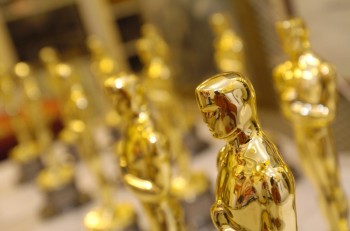 - On Tuesday I’d posted all of the titles to those films which had passed the requirements to be eligible to compete for the Oscar for Best Animated Short Film. A few years back when I had done this, I’d received a number of letters from the Academy telling me that I was violating some rule or other. Actually, I think the violation was that I’d made a comment or three as I’m wont to do. That’s verboten and I was threatened that I might lose ©2012 MPAA
- On Tuesday I’d posted all of the titles to those films which had passed the requirements to be eligible to compete for the Oscar for Best Animated Short Film. A few years back when I had done this, I’d received a number of letters from the Academy telling me that I was violating some rule or other. Actually, I think the violation was that I’d made a comment or three as I’m wont to do. That’s verboten and I was threatened that I might lose ©2012 MPAA
membership if I didn’t behave. The next year
the titles were released on Cartoon Brew, then the Academy officially released the titles.
Maybe I helped change a rule.
This year I released the titles with some apprehension, but I didn’t really make any comments about the films. I just named some films that stood out in my mind. I don’t necessarily like all of those films, but for some reason or other they did stand out in my memory.
A few of the film makers contacted me afterward to get my opinion or advice about their shorts. All I could do was congratulate them all for having gotten to this point. It is exciting. The prospect of a nomination is a thrill that I lived through a couple of times, and one time I was actually nominated.
I wish them all luck. Let’s hope the ones with the big budget advertising campaigns don’t affect the judgements on the that have enormous ad campaigns behind them to tell us all how good these films are. They’ve all entered the twilight zone.
Another Sort of Campaign
- Mark Sonntag has begun another sort of campaign. Bounty Hunter Bunny is an animated film Mark is looking to make, and he’s set up an Indiegogo campaign to raise $10,000 for it. He has also set up a blog for the film; Bounty Hunter Bunny, the blog.
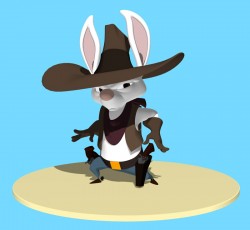 Mark is an accomplished animator working out of Australia. He started early, making films on super 8mm at age 14 and has been in the business forever. Everything from Ren and Stimpy to The King and I has passed through his pencil, and he also has one of the finest blogs out there. Tagtoonz is pure animation history and a must-stop for those interested in animation’s past.
Mark is an accomplished animator working out of Australia. He started early, making films on super 8mm at age 14 and has been in the business forever. Everything from Ren and Stimpy to The King and I has passed through his pencil, and he also has one of the finest blogs out there. Tagtoonz is pure animation history and a must-stop for those interested in animation’s past.
It’s a cgi film that I feel confident in supporting. I’d encourage you at least to view the animatic on display; it’s really promising.
Go to: Bounty Hunter Bunny
The models look smart and the storyboard is exceptional. I like how he’s used the style to make the cg art look like rendered 2D. It’s very nice.
Good luck, Mark.
Daily post 01 Nov 2012 11:20 am
Here Comes the Sun
I have a problem. The hurricane, Sandy I mean, left me without electricity or heat. Fortunately, I have hot water and a gas oven. However, I don’t have access to a computer or the internet. Friends have been posting material I’d prepared, and those are running downhill quickly (material prepared, I mean, not friends.) I’ve decided that I’d post this today, and it would have to hold until I get electricity back. Maybe by the weekend, please Mr. Mayor.
So I leave you with Our Mr. Sun, hoping he comes to warm us all, soon. It shouldn’t be more than a couple of days. If I get to another computer, I’ll add something more. Best, Michael
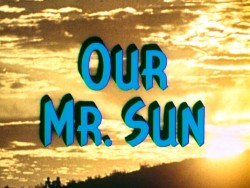 - Back in the 50′s the film director, Frank Capra, produced, directed and wrote four specials for TV which were sponsored by Bell. Our Mr. Sun (1956), Hemo the Magnificent (1957), Unchained Goddess (1958) and The Strange Case of the Cosmic Rays (1957) were devoted to explaining basic science to family home audiences. Capra was educated as an engineer, so he had a lifelong interest in science and he initiated these prorams.
- Back in the 50′s the film director, Frank Capra, produced, directed and wrote four specials for TV which were sponsored by Bell. Our Mr. Sun (1956), Hemo the Magnificent (1957), Unchained Goddess (1958) and The Strange Case of the Cosmic Rays (1957) were devoted to explaining basic science to family home audiences. Capra was educated as an engineer, so he had a lifelong interest in science and he initiated these prorams.
Capra also had a long time interest in animation. He was responsible for securing a distribution contract for Disney with Columbia back in the early 30′s. Animation became a large part of these four programs, and Capra found different animation houses to do them. UPA, Disney, Shamus Culhane‘s studio and WB all were involved.
UPA did the artwork for Our Mr. Sun, the first of these programs. (You can watch it here.) I have a copy of the script marked up by Grim Natwick, so I know he animated on it out of the NY studio of UPA.
The shows play a bit like Ward Kimball‘s “Tomorrowland” episodes of the Disneyland television show. Perhaps these are a bit less joke oriented. The animation is just as limited and design oriented. This format has forever affected many who grew up watching them. Check out the new Pixar 2D piece, You’re The Rat, currently on YouTube (it’ll probably be removed soon.) There’s an obvious link.
Here are some frame grabs from this first show of the Bell Science Series: Our Mr. Sun.
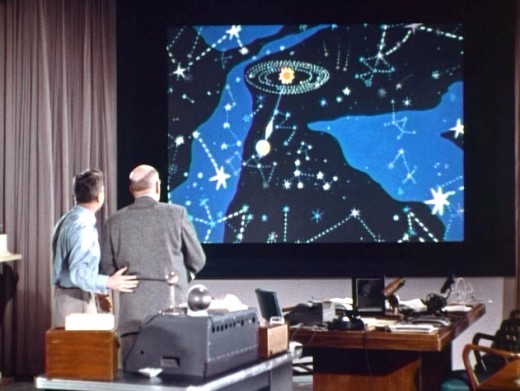
(Cllick any image to enlarge.)
Commentary &Daily post 23 Oct 2012 06:32 am
Inspired Perspiration
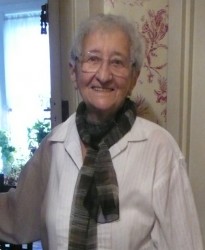 Before getting into it, let me remind those living in NYC, there will be a memorial service for Tissa David who passed away last month. Tissa was something of an original, a female animator who could draw with the best of them. She animated plenty of footage for the Hubleys, Dick Williams, R.O. Blechman and my studio, Michael Sporn Animation. Clips will be shown from many of her films, and five speakers will talk about Ms. David.
Before getting into it, let me remind those living in NYC, there will be a memorial service for Tissa David who passed away last month. Tissa was something of an original, a female animator who could draw with the best of them. She animated plenty of footage for the Hubleys, Dick Williams, R.O. Blechman and my studio, Michael Sporn Animation. Clips will be shown from many of her films, and five speakers will talk about Ms. David.
It starts at 7pm at the
Academy Theater at the Lighthouse,
111 East 59th St, lower level.
There’s no charge.
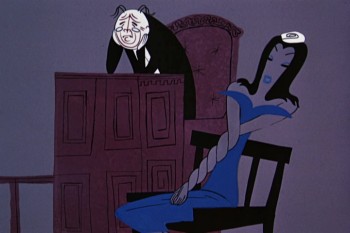 -I was thinking about Rooty Toot Toot the other day. Actually, I wasn’t, I was thinking about some of the ugly designs that came out of other lesser UPA films. Some, like Rooty Toot Toot, were those of animation’s greatest design ever done. The bad ones had characters borrowed out of 19th century illustration, and they didn’t blend in with the 20th century art that others were designing for the very same films.
-I was thinking about Rooty Toot Toot the other day. Actually, I wasn’t, I was thinking about some of the ugly designs that came out of other lesser UPA films. Some, like Rooty Toot Toot, were those of animation’s greatest design ever done. The bad ones had characters borrowed out of 19th century illustration, and they didn’t blend in with the 20th century art that others were designing for the very same films.
I think of characters in several of the Art Babbitt directed films at the studio. They just didn’t work. Brilliant backgrounds of Paul Julian just didn’t have the support from the unattractive characters. The characters just didn’t approach the same level of design; in fact, they fought the Bgs which tried very hard to work. Actually, Babbitt’s films don’t seem to fit into the canon of work that came from the studio at the very time they were being developed.
A quick mental jump, and I was thinking about John Hubley and the characters in Rooty Toot Toot. They’re definitely the outgrowth of some modern approach to character design in illustration. Ben Shahn had his influence there, as did Thomas Hart Benton and Saul Steinberg.
Hubley was a working artist. He spent time looking at, working with and studying other artists religiously. He never lost his curiosity when I knew him and applied it to his art. When he did the 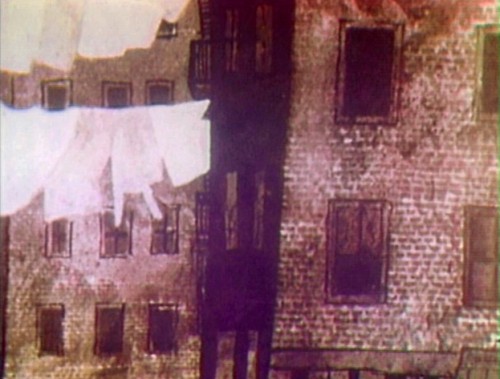 Letterman gig for The Electric Company, he pulled out Paul Klee and studied all those Klee’s with cross-hatching and mottled watercolor. Then he turned to George Herriman and Krazy Kat. During Carousel there were plenty of artists to study and John did. He wasn’t looking to steal from the greats; he just wanted to understand how another artist had solved a similar problem. This was second nature to Hubley. Gregorio Prestopino‘s design for Harlem Wednesday.
Letterman gig for The Electric Company, he pulled out Paul Klee and studied all those Klee’s with cross-hatching and mottled watercolor. Then he turned to George Herriman and Krazy Kat. During Carousel there were plenty of artists to study and John did. He wasn’t looking to steal from the greats; he just wanted to understand how another artist had solved a similar problem. This was second nature to Hubley. Gregorio Prestopino‘s design for Harlem Wednesday.
,
In the fifties and early sixties, John was taken with the work of Gregorio Prestopino , and brought him into the mix. A 10 min short film evolved, Harlem Wednesday (1957). At UPA, the younger Hubley sparkled with intelligence and purpose in his design, and he acted as a force at UPA when things got big.
Hubley loved many other artists. Who knows what the reference was for Rooty Toot Toot, but we know that there was a group of artists that got Hubley rowling, and the end result was rich.
At the Disney studio a different sort of reference was pulled out for study. Disney brought illustration designers like Frederick Horvath and Albert Hurter to the studio. Dsney reached deeply into the European fairy tale illustrators. If he had been able to bring Edmund Dulac or Arthur Rackham into the studio, he would have. As it is, he brought the best he could find.
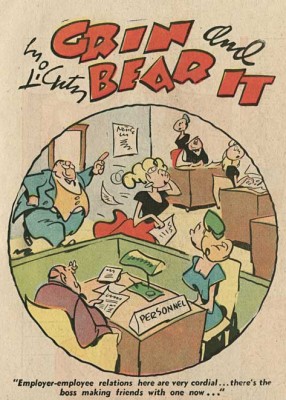 Heinrich Kley and Wilhelm M. Busch. 19th century artists whose principal focus is on the body and physical gesture, this is the strength of animators. Anyone can appreciate their strong work, but animators are particularly attuned to such reference material. Many other animators look toward other cartoonists. Rod Scribner was in love with George Lichty‘s comic strip “Grin and Bear It.” He studied Lichty, religiously, for inspiration, and the result was that great style.
Heinrich Kley and Wilhelm M. Busch. 19th century artists whose principal focus is on the body and physical gesture, this is the strength of animators. Anyone can appreciate their strong work, but animators are particularly attuned to such reference material. Many other animators look toward other cartoonists. Rod Scribner was in love with George Lichty‘s comic strip “Grin and Bear It.” He studied Lichty, religiously, for inspiration, and the result was that great style.
Both types of reference are important. As long as it gets the mind to the next step. Art means you’re trying to continue making art; cartoon references means you’re trying to make a cartoon. Is it necessarily true that if you’re referencing “Art” you’re going to end up with “Art” and if you reference cartoons it means your end work will not be “Art”? No, the answer is no. Who knows what kind of reference Jim Tyer was going for, but some of the animation he did takes animation to another level, one that only Tyer can reach with his uniquely individual style.
Actually, let’s move down another generation. All the Don Bluth films analyzed, studied and reworked the Disney classics while those animation workers told themselves they were in homage of the Disney classics. When the end result becomes a Thumbelina or Gnome in Central Park, you’re not going to find much “Art” in the film. But then Disney animation took it lower.
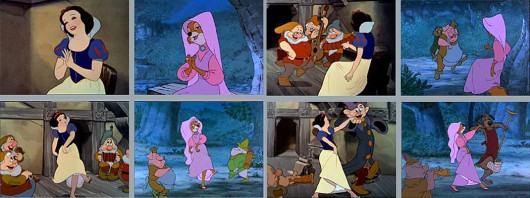
Is it live or is it Memorex? Or maybe Romnesia?
Woolie Reitherman‘s reuse of so many scenes from the Disney classics makes us wonder if there was still talent in the studio. Where was Ken Anderson, Milt Kahl, Frank Thomas and Ollie Johnston when Woolie was trashing Disney? Why didn’t those bosses speak out against it? Sure, they wanted to cut costs, but did they have to take that route? How many
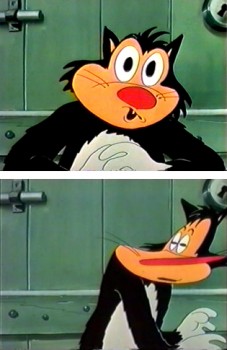 times do we have to see Snow White dancing with the dwarves – I mean Maid Marian dancing with small animals – to realize that we’re looking at bad animation reuse. It’s not an homage, it’s just cheap. But then Woolie Reitherman was chockablock with cheap ideas as a director. That disco sequence in The Aristocats couldn’t have felt any more bankrupt, just when Disney animation needed to be at the top of its game, Woolie brought it to its lowest point.
times do we have to see Snow White dancing with the dwarves – I mean Maid Marian dancing with small animals – to realize that we’re looking at bad animation reuse. It’s not an homage, it’s just cheap. But then Woolie Reitherman was chockablock with cheap ideas as a director. That disco sequence in The Aristocats couldn’t have felt any more bankrupt, just when Disney animation needed to be at the top of its game, Woolie brought it to its lowest point.
Taking inspiration from animators or animation classics doesn’t necessarily pull you to the bottom of the junk heap. Bakshi pushed John Kricflusi into the genius of Jim Tyer‘s scenes, and a new style emerged. Granted it isn’t always art but it is original. John K has spawned a whole new world of wildness among many of the younger people. I’m not sure that’s good, but I am sure that some of the work he, personally, has been doing is rich and inspired.
Woolie Reitherman was just looking for a way out of a tight budget; John K uses his tight budget as a way of taking Jim Tyer to another level.
Art Art &Bill Peckmann &Books &Daily post 12 Oct 2012 05:30 am
Western Art
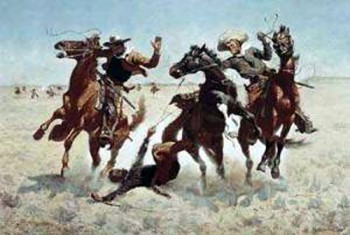 – I have a love/hate relationship with western art. The truly great, such as Remington, give a power and majesty through an extraordinarily honest approach to the world they found, pristine of the footsteps of western man. Many of the later followers are not quite as brilliant to my taste. I appreciate the extraordinary artistry and craftsmanship of many of these painters, but they stand on a plateau much lower than that of the great. Of course, there’s a wide variation among these artists, and they were searching for something very different than a Remington or a Charles M. Russell or Albert Bierstadt.
– I have a love/hate relationship with western art. The truly great, such as Remington, give a power and majesty through an extraordinarily honest approach to the world they found, pristine of the footsteps of western man. Many of the later followers are not quite as brilliant to my taste. I appreciate the extraordinary artistry and craftsmanship of many of these painters, but they stand on a plateau much lower than that of the great. Of course, there’s a wide variation among these artists, and they were searching for something very different than a Remington or a Charles M. Russell or Albert Bierstadt.
Bill Peckmann has sent some beautiful works of what seem to be predominantly early 20th century art. There’s a nice variation among the artists, some are on the genius level others aren’t quite as great. Some such as Thomas Hart Benton don’t seem to fit properly into the overall scheme as a “Western” artist. He seems more like a Mid-Western painter, a WPA artist, rather than a Western one, but I’ll post anything by him anytime. He’s exceptional, to say the least.
Here are Bill’s comments:
- Growing up in the Bronx with all of that asphalt, bricks and mortar years ago, it was very easy at that time to become enamored with the wide open spaces and succulent sagebrush scenery of comic book, movie and TV westerns. Like all first loves, those images had a way sticking with you through life. (In most of those oaters, I’d say the scenery often got the upper hand with a lot of those gunslinging heroes.) Somewhat older now, (and hopefully with a little better handle on the arts) it’s nice to see that ‘fine art’ western painting still has that same ability to make you want to become an ol’ cowhand.
Here is a sampling from different art books of a few of the artists who captured the best of the West.
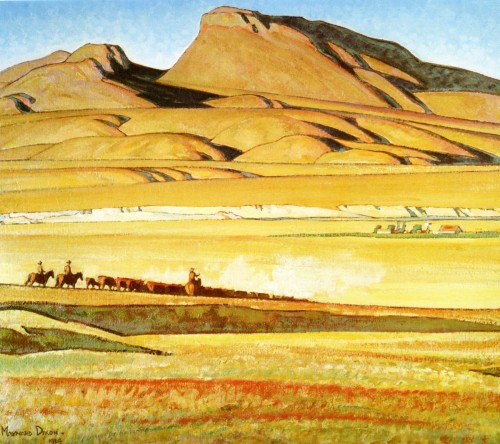 1
1Here is Maynard Dixon. (IMHO one of the greats, a western Edward Hopper.)
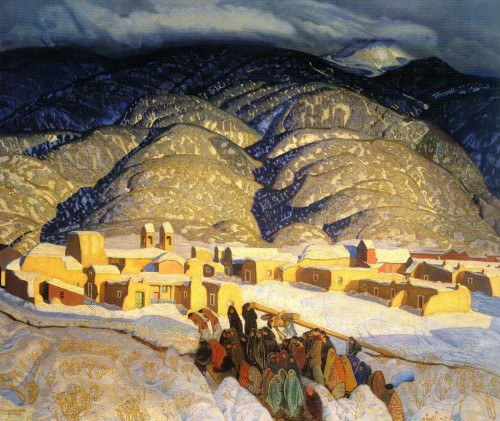 5
5
Ernest Blumenschein.
(This painting still floors me every time I look at it.)
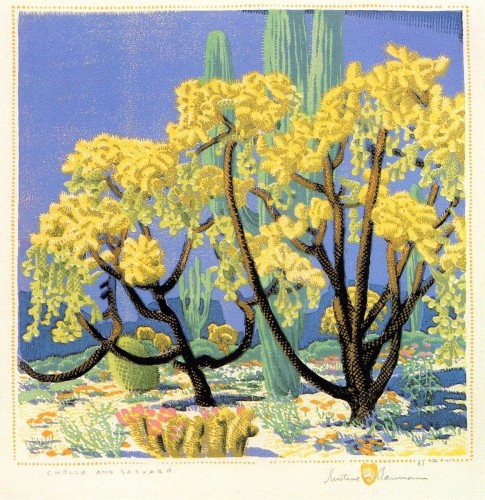 6
6
Gustave Baumann.
A western woodcut artist, a niche he made all his own.
Maynard Dixon
Books &Daily post 29 Sep 2012 06:55 am
Egos, Books, and Michel Ocelot
There’s been a relatively short conversation going on at the comment section of my blog for an older piece I’d repeated this past week. The discussion has been about Eyvind Earle. The first few visitors who commented all wanted to express their dislike of this film (particularly the story) and Eyvind Earle’s design work, in particular. “Scott’s” dislike of Mr. Earle’s work extends to his personal attitude while working on the film. He, according to “Scott”, was thick headed and wouldn’t listen to any requested changes to his designs, allowing his ego to take charge of the work. (I’m not sure that I see that on the screen, nor did I really feel that when I met the man when I got to spend an afternoon with him as I accompanied Mike Barrier on an interview. I admit it is possible though.)
In fact, I think the ego is essential in breaking new waves and advancing the art form. Adam Abraham in his book When Magoo Flew writes about the ego of John Hubley in running his productions at UPA. If he wanted a specific blue, that’s all that he would settle for. The report is that he was oppressively insistent on it being his way only. I worked for Hubley for years and never got to see that side of the man. Oh, there was a well deserved and big ego there, but it never got in the way of the art being created.
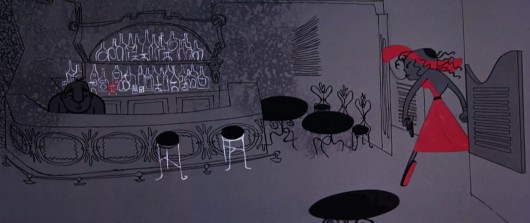
Rooty Toot Toot
We’ve seen Bill Peet complain about Bill Tytla‘s use of his (Peet’s) drawings while working on Dumbo. According to what I’ve read, Peet complains that Tytla took full credit for the sequence of baby Dumbo running in and around his mother’s legs, when Peet felt it was his scene, his key drawings that made the scene the perfect piece that it was.
Chuck Jones, while working briefly for Disney (on Sleeping Beauty), told Walt that he had to leave the studio. When Disney asked what job Jones really wanted at the studio, Jones said, “Yours.” He felt that only Disney’s job was suitable for him. Talk about ego. The ego was even larger than that when you realize that it was Jones, hmself, that told me that story – however real it actuall was. The egos of Jones and Clampett and even Freleng vie over who created what character.
Egos are necessary in an industry of craftspeople and artisans, especially when an artist is trying to get something brilliant out of them. Thomas, Johnston, and even Kahl were brilliant actors with amazing abilities of draftsmanship. But the film, the bigger picture, needed a direction which Earle gave it. Just look at the wretched Reitherman films to see what Thomas, Johnston and Kahl turned out without the strong, smart director who was also an artist. Tytla took animation to another level, he was truly an artist, himself, but look at the miserable little films he directed when he left Disney’s studio. Even the support system of that studio wouldn’t have helped Leprechauns Gold or Snap Happy. (Mind you, I love Snap Happy, but it has no relation to art.)
Here’s a small piece David Parfitt wrote:
- Tytla was a tough guy who used abusive language and irritated his fellow animators. Ken Anderson (Disney Legend for Animation and Imagineering) went to Walt Disney to express frustration at the way Tytla treated his coworkers. Walt Disney replied, “What do you think of Chernabog, the God of evil, in ‘Fantasia’? What do you think of Stromboli in ‘Pinocchio’?†Anderson (the art director for both films) replied, “They are some of the most powerful and vicious villains we’ve ever done.†Walt Disney looked at Anderson and said, “Where do you think all that anger comes from?†Vladimir Tytla was a maverick who needed to release anger and energy to manifest some of the most powerful imagery ever produced by the Disney Studios. A maverick is difficult for a company to grapple with because of their abrasiveness and the way they go against the way things typically run. Yet out of the agitation and irritation often comes a new direction that could secure a company’s future.
Sleeping Beauty changed the Disney studio forever. The animators and artists there, with the exception of Ward Kimball and a few others, fought against the use of 20th century graphics in their films, yet UPA’s influence slowly crept into the mix. Finally when Walt Disney, himself, chose Eyvind Earle and put full support behind him to design this film as he saw fit. The animators all fought Earle and continued to bad mouth him to the end of their days. Yet Earle’s style, as well as Tom Oreb‘s great character designs for that film, are frequently copied by the new generations of artists. The backgrounds and some of the character design are stolen directly from Sleeping Beauty. Even though the SB art is a play on 15th Century manuscripts and art, it was used for the Pocahontas forests.

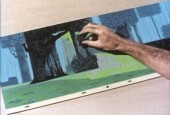

Painting Sleeping Beauty
Nothing at Disney, with the possible exception of Bedknobs and Broomsticks went back to the past to illustrate their films henceforth. Until, of course, today’s new artists in animation who just steal from other past films. Bluth‘s Small One or is virtually without style. Tim Burton is possibly the only exception I can see of this current view of the state of animation. The regurgitated past of other artists who deservedly had egos aglow. We go on. Perhaps someone like Genndy Tartakovsky will bring some of the panasche he brought to Samurai Jack.
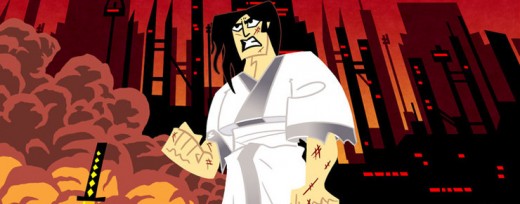
Samurai Jack
By the way, there’s a good interview with Tartakovsky on this week’s on-line version of the Village Voice.
Books
.
- There are a couple of books I’d like to write about.
.
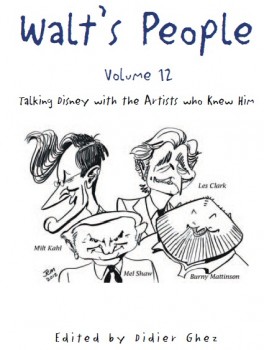
- Let me mention Didier Ghez‘ latest volume of his interview series, Walt’s People.
Just released is Walt’s People – Vol. 12. Just the idea of 12 volumes of any book in print, is quite extraordinary, and amazing feat for Didier Ghez to pull off.
I own about a half dozen of this series and have read all of them at least twice. Most of the interviews are exceptional, some are smart, and the rest are just very good. In all there are those interviews that give us some real insight into the process and history of the making of animated films by the professionals who did it. Les Clark, Larry Clemmons, Charlie Downs, Al Eugster, Sammy Fain, Milt Kahl, Burny Mattinson, Paul Murry, and Mel Shaw are among the many who are interviewed in depth for this new volume. Some of our greatest historians (Robin Allan, Michael Barrier, Albert Becattini, John Canemaker, John Culhane, Pete Docter, Chris Finch, J.B. Kaufman, Jim Korkis, Dave Smith, and Charles Solomon among others) conduct the interviews.
It’s just another great volume in the series. You should own them all; I should own them all, to be honest, and I will.
Ganesha’s Sweet Tooth
- As previously reviewed on this blog, Sanjay Patel will see his first children’s book, Ganesha’s Sweet Tooth released this week by Chronicle Books. I have a sore spot for Mr. Patel’s work. He’s an artist who works by day at Pixar and is an artist, with his own very defined style, working extensively after hours.
I’ve reviewed many of his books and have a real fondness for The Ramayana. Were I you, looking to explore this artist’s work, I’d buy Ganesha’s Sweet Tooth. Once you have it and want more – you will – go for The Ramayana. It’s a brilliant masterwork.
Snow White x 2
- Unless you’ve been hiding under a rock, if you’re an animation fan, you know that the brilliant historian, J.B. Kaufman, has not one but TWO books on Snow White about to appear on the market.
The Fairest One of All: The Making of Walt Disney’s Snow White and the Seven Dwarfs and
Snow White and the Seven Dwarfs: The Art and Creation of Walt Disney’s Classic Animated Film
are the two titles by Kaufman that focus in great depth on that film and its development. This is to celebrate the 75th anniversary of the feature, and will coincide with a display that will appear soon at the Walt Disney Family Museum in San Francisco.
Both books come from the Walt Disney Family Foundation in conjunction with the Walt Disney Family Museum. I’ve seen the Art of Creation book, and was completely taken with it. I will most definitely own both books. The film means much to me, and I want to own anything Kaufman writes. It’s a no-brainer – double my pleasure.
By the way, part of the reason I’m looking forward to reading these two books is to compare it with Michael Barrier‘s amazing writing on this period at Disney’s studio. In Hollywood Cartoons, there’s a large part of the book dedicated to the development andcreation of this particular film. Then in The Animated Man: A Life of Walt Disney Barrier tells the same information but from a different perspective entirely. This biography of Disney is wholly involved with Walt Disney, the man and artist. It’s a unique turn that we only see in the poorly written Diane Disney Miller book, The Story of Walt Disney. As Walt’s young daughter she could see the story no other way than from his perspective. While waiting for the Kaufman books to come out, read either of Barrier’s books for the best, to date, version of the Snow White story. It’s strong writing.
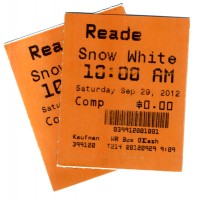 It’s appropriate that I was invited to a 10am screening of Snow White at Lincoln Center this morning. It’s part of the NY Film Festival’s 50th anniversary celebration. Eric Goldberg introduced the film with a brief and smart little talk about the animation. Talking about The Old Mill as a test run for the Multiplane Camera, talking about the Three Little Pigs first offering characters that looked alike but had characterization defined by their animation (as did the dwarfs), talking about The Goddess of Spring being an enormous failure for Ham Luske who succeeded animating Snow White. It was nice to say hello to Eric prior to the film. We haven’t seen each other in about five years. It was nice also to see the film projected. I saw the movie on tv/dvd only a couple of weeks ago, but it’s a very different experience on the big screen. The digital transfer was glorious, merciless and disastrous. The ink lines were so sharp that you could actually feel how deeply the crow quills cut into the cels. However there were many points where individual frames had slight digital distortion to hurt the ink lines, and the magic mirror actually had the detritus of digital compression across the center of the mirror. Someone should have been there to supervise the transfer.
It’s appropriate that I was invited to a 10am screening of Snow White at Lincoln Center this morning. It’s part of the NY Film Festival’s 50th anniversary celebration. Eric Goldberg introduced the film with a brief and smart little talk about the animation. Talking about The Old Mill as a test run for the Multiplane Camera, talking about the Three Little Pigs first offering characters that looked alike but had characterization defined by their animation (as did the dwarfs), talking about The Goddess of Spring being an enormous failure for Ham Luske who succeeded animating Snow White. It was nice to say hello to Eric prior to the film. We haven’t seen each other in about five years. It was nice also to see the film projected. I saw the movie on tv/dvd only a couple of weeks ago, but it’s a very different experience on the big screen. The digital transfer was glorious, merciless and disastrous. The ink lines were so sharp that you could actually feel how deeply the crow quills cut into the cels. However there were many points where individual frames had slight digital distortion to hurt the ink lines, and the magic mirror actually had the detritus of digital compression across the center of the mirror. Someone should have been there to supervise the transfer.
Paperman played prior to Snow White. It was animated cgi, then flattened and lines were added atop the flattened drawings. I can’t for the life of me understand why it wasn’t just animated by hand. It would have cut the cost in half and had more life to it. Sorry, I don’t think it worth the Oscar. Though you never know it may be the best film, this year.
Tales of the Night
- Michel Ocelot has received another excellent review from the NYTimes. Tales of the Nightis reviewed by Andy Webster in the Times, and is Ocelot’s latest feature length animated film – his first in 3D – and the reviews are sensational. It’s screening as part of the Children’s International Film Festival and plays at New York’s IFC Theater through next Tuesday. This is a silhouette film in brilliant color.
His films are beautiful and deserve to be seen in a theater. I’d heartily recommend getting to the theater if you have the chance. Hopefully the distributor will submit this one for Oscar consideration. Though the look is 2D, the graphics are done via cgi as was the case with his past films, including Azur & Asmar, Kirikou et les betes sauvages, Princes and Princesses, and Kirikou and the Sorceress.
Some amazing animation is coming out of France these days.
More Reviews
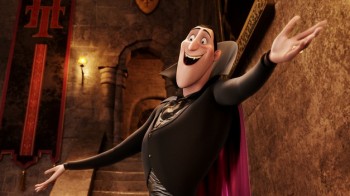 Now to the bigger release for the smaller film department:
Now to the bigger release for the smaller film department:
Adam Sandler‘s second animated feature, Hotel Transylvania, opened to mostly poor reviews by 2nd string reviewers.
NYTimes sent Neil Genzlinger to give his negative review. The most positive line is: “The movie loses its originality as it rolls toward its predictable conclusion, but it’s still lovely to look at.”
Someone named Sara Stewart reviews the film for the NYPost and gives it a middling 2½ stars. “Director Genndy Tartakovsky (“The Powerpuff Girls,†“Samurai Jackâ€) is a natural fit for this kid-and-parent-friendly flick. The animator’s wit and attention to detail enliven a collection of well-known ghosts and ghouls. (Though Tartakovsky’s more traditional TV-cartoon style is still superior, as evidenced by his playful closing credits.)”
Joe Neumaier, the 2nd rate first stringer of the NYDaily news gave it a mostly positive 3 star review. “This being a Sandler movie, the humor skews toward the infantile (fart jokes, peeing baby werewolves). But the sleek visuals are rich and glossy, placing the characters, who look like Halloween door decorations, in baroque hallways or secret passageways.”
I enjoy the reviews in The Onion, and their review for this film by Tasha Robinson doesn’t disappoint. A C+: “Tartakovsky gets a long way on wild design and visually daring sequences. His work has always been adventurous, experimental, and conceptually creative, and he hasn’t lost any of his energy or capacity for staging a memorable setpiece.”
Whatever happened to the feature length version of Samurai Jack that J.J. Abrams was going to produce wth Tartakovsky directing?
Bill Peckmann &Commentary &Daily post &Rowland B. Wilson 21 Sep 2012 05:19 am
RBW at Auction and otherwise
- If you’ve ever wanted to own a Rowland B. Wilson cartoon, now’s your chance. A number of Playboy cartoons by Wilson are up for auction via Heritage Auctions. The auction will end on Oct. 13th, and you can make a bid now, if you like. I’ve posted the cartoons available below with some of the descriptive material from the auction house. Good luck.
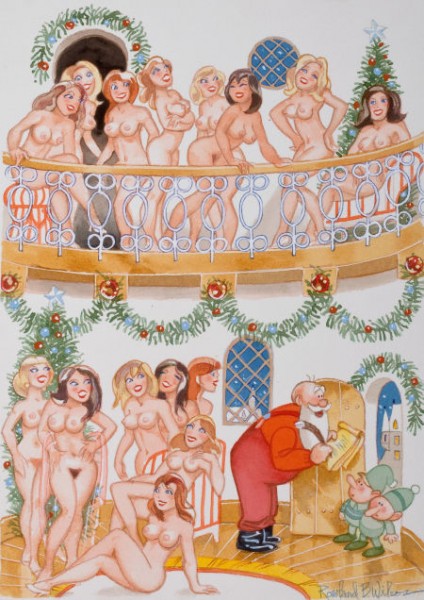 1
1“This Year I’m Putting in a Provision For Good Big Boys Too!”
Playboy page cartoon illustration, January 2002
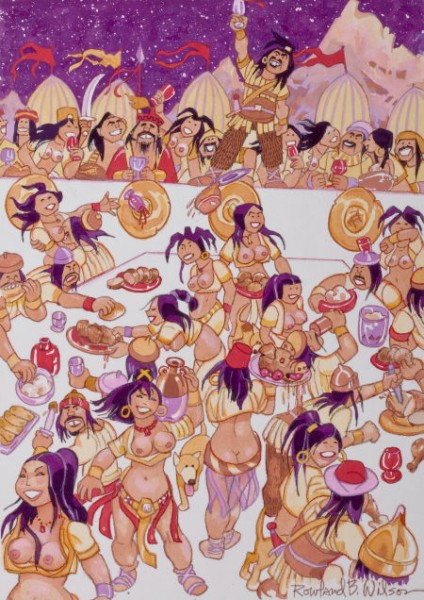 2
2
“A Toast to the New Year!
May It Be Another Prosperous One For Atilla and All Us Huns!”
Playboy cartoon illustration, January 2003
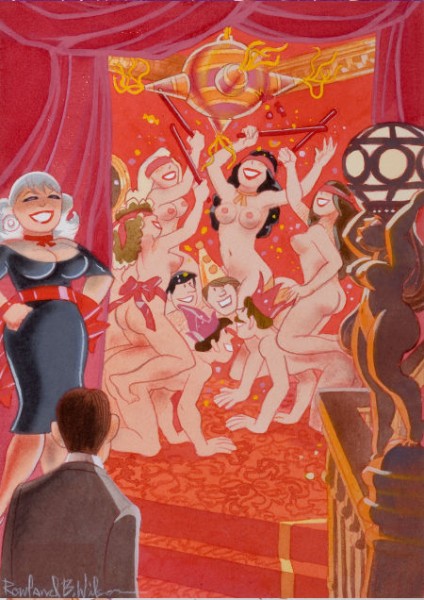 3
3
“We’ve Added a New Kink to the Piñata Tradition!
Playboy cartoon illustration
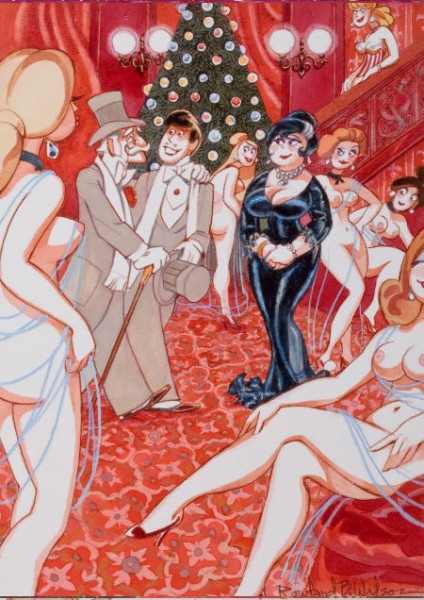 4
4
“At Long Last, Grandfather, You’ve Taken Me to See the Nutcracker”
Playboy cartoon illustration, January 2000
 5
5
“If I Can Bring This Lovely Creature to Life,
She Will Bring Me Everlasting Immorality!”
Playboy cartoon illustration, November 1981
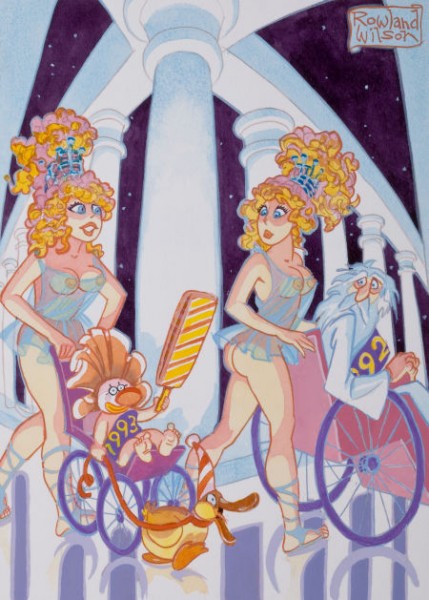 6
6
“I Have a Feeling ’93 is Going to Be a Very Weird Year”
Playboy cartoon illustration, circa 1993
 7
7
“Miss Perkins Has a Perfect Record in Dealing with Potential Suicides”
Playboy cartoon illustration, May 2003
______________________
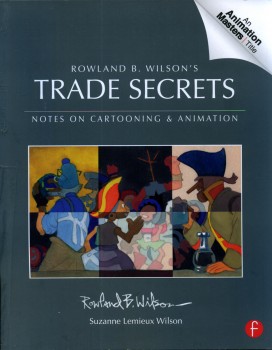 And as long as we’re talking about Rowland Wilson, I can’t pass up the chance to tell you, yet again, how great Trade Secrets is. Subtitled, “Notes on Cartooning and Animation,” the book is so much more than that. It’s a lifetime’s worth of invaluable notes, advice and commentary about illustration, cartooning and (most importantly to me) animation. I’ve read large chunks of this book over and over again. It all seems so basic and simple, when you’re deep into it, but the book is thick with brilliant comments about the art of drawing and painting. You’ve got to get your hands on it just to see how rich the material is. Once you do, though, you’re going to want to own it. I feel not only indebted to Rowland for the material but to Suzanne Lemmieux Wilson for having finished the book and making sure it looks as perfect as it does. It’s a treasure.
And as long as we’re talking about Rowland Wilson, I can’t pass up the chance to tell you, yet again, how great Trade Secrets is. Subtitled, “Notes on Cartooning and Animation,” the book is so much more than that. It’s a lifetime’s worth of invaluable notes, advice and commentary about illustration, cartooning and (most importantly to me) animation. I’ve read large chunks of this book over and over again. It all seems so basic and simple, when you’re deep into it, but the book is thick with brilliant comments about the art of drawing and painting. You’ve got to get your hands on it just to see how rich the material is. Once you do, though, you’re going to want to own it. I feel not only indebted to Rowland for the material but to Suzanne Lemmieux Wilson for having finished the book and making sure it looks as perfect as it does. It’s a treasure.
To give another view of some other advertising work done by Rowland Wilson, Bill Peckmann forwarded these pieces. Here’s Bill:
- I thought maybe you would enjoy seeing the original art of two Phil Kimelman & Ass. house ads. The first one is all Rowland Wilson, both concept and finished art, the second one is a collaboration of Rowlie and Alex Toth.
We’ll start with the printed ad as it appeared in Millimeter magazine in 1979, and then do close ups of the original art.
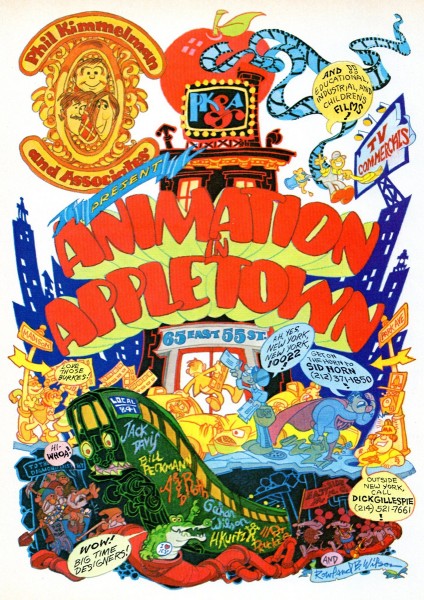
The full sized ad
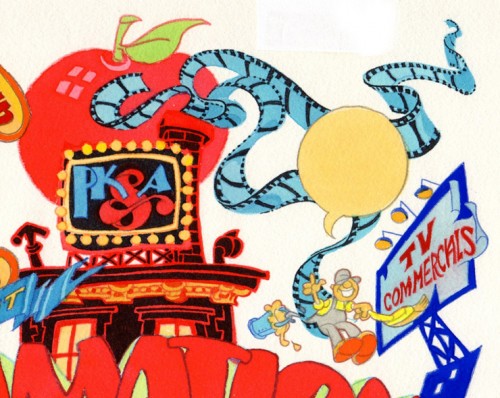
No lettering in the word balloons, that was done on a separate over lay.
The second PK&A house ad was written by Rowland Wilson, Alex Toth did the finished black and white art and then Rowland colored it with his water colors.
Here’s the black and white.
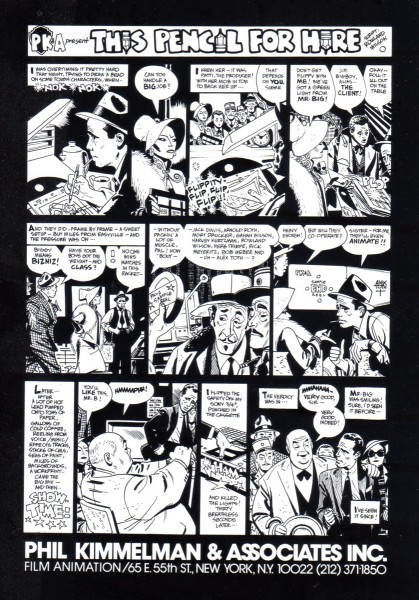
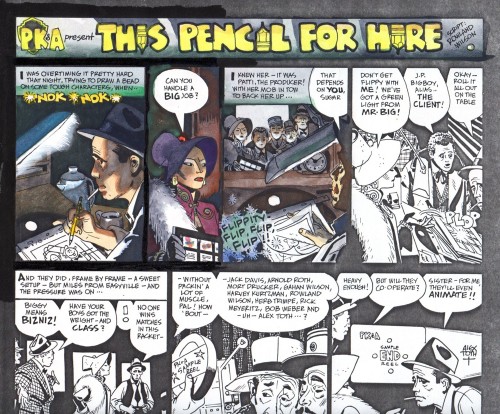
We took Alex’s original art, xeroxed that on to kid finished
Bristol board, the paper Rowland always worked on.
Here is an unfinished, experimental start by Rowland.
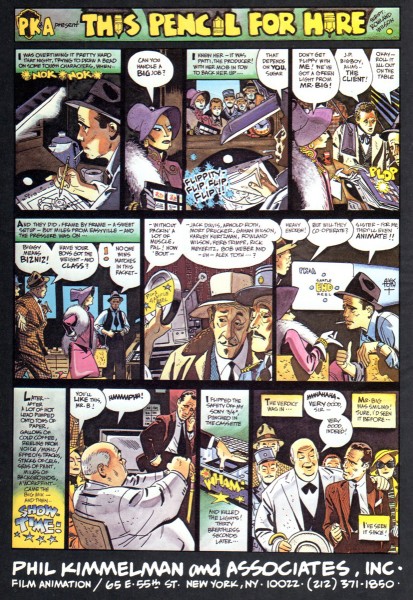
The only time the ad ever ran in color was here
in the 1982 International Film Guide paperback.
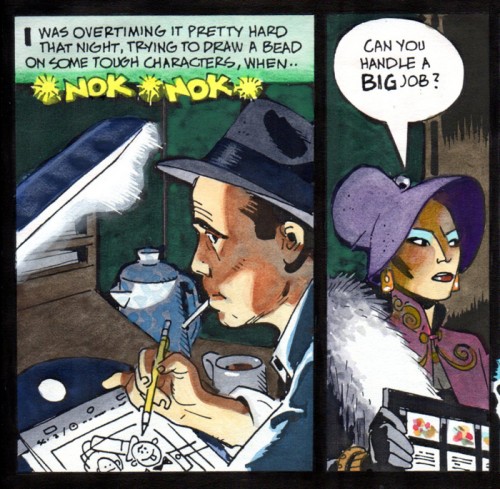
Hopefully all will enjoy these panels in their large format
and be able to see how each one works by itself
in the drawing and the coloring.
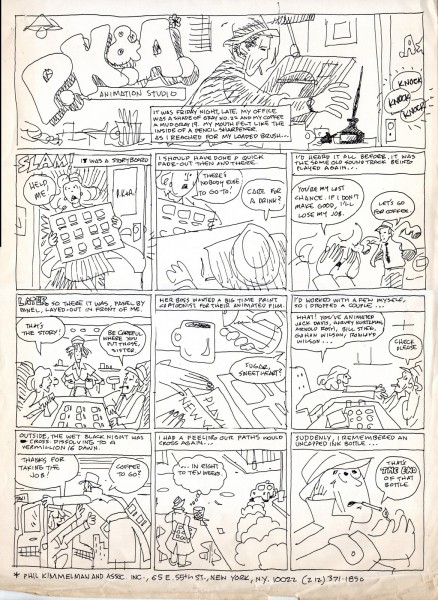
Here is a small footnote to the history of the ‘Pencil for Hire’ ad.
It’s my rough that started the ball rolling. I was hoping to entice
Alex into doing a take off on a Milton Caniff type Sunday comics
page for our house ad. Fortunately, Rowland was looking over
my shoulder and thought it was time for a rewrite!
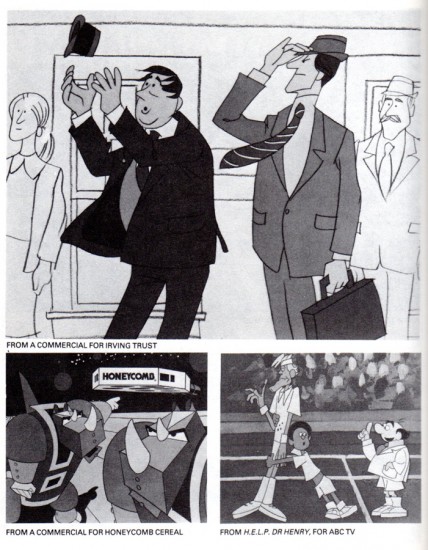
The 1982 Film Guide also contained this page, the “Irving Trust” commercial
and the “Dr. Henry” series were designed by Rowland, the “Honeycomb” spot by me.
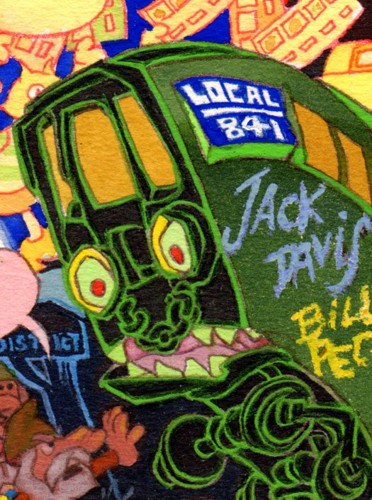
PS: I wanted to end on this button. For all of us who
still remember “Local 841″ and green subway cars!
Commentary &Daily post 21 Jun 2012 06:21 am
Brave
- I saw Pixar’s Brave on Tuesday night. It’s not a perfect film, but it’s certainly the best film they’ve done since Ratatouille. I have my share of complaints but was quite surprised it’s as good a film as it is. Let’s start off with the story.
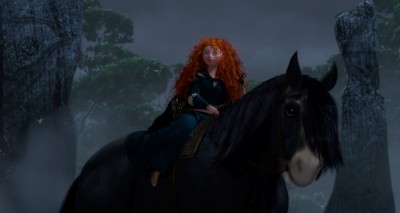 I was surprised the story isn’t quite as cliched as I expected. As a matter of fact, there are many things that aren’t expected in the story, and it turns in some unusual ways that are very positive.
I was surprised the story isn’t quite as cliched as I expected. As a matter of fact, there are many things that aren’t expected in the story, and it turns in some unusual ways that are very positive.
Probably giving away some spoilers, the story is this: A young, immature Scottish princess follows the lead of her father as she tries to make herself into a tomboy warrior, an expert archer, while her mother continually cajoles her into acting properly as a princess should. Things build to a head when her mother sets up three suitors to meet with her hoping to find a future husband for the girl, Merida.
Merida contacts a witch for a spell to transform the mother, to get mom off her back. But the potion, of course, runs afoul of the plan when it turns the mother into something unexpected. The plot thickens, as they have 48 hours to break the spell.
Up to the introduction of the witch character (who reminds me both of Andreas Deja’s Madame Odie from the Princess and the Frog and the Mad Madame Mim from Sword in the Stone), the story is thoroughly entertaining. It takes an obvious turn or two, then it gets wonderful again with focus on the Queen Mother. This is the best and funniest animation in the film. She’s a wonderful character who reminds me a bit of a minor but delightful Chuck Jones character.
The ending is forced as all the men are given short shrift; they act like dolts for the last third of the film. There isn’t one male in the film that we can look up to. In fact, the father who starts out as a strong and solid heroic type, with a subtle and charming character, turns fool like all the other males. Merida rejects the suitors out of the box, yet they’re all doofish and unattractive characters. It would have made more sense to have one of them look the part of a hero, then the girl’s rejection would make more intellectual sense. As it is, she’d be an idiot to accept any of them (and you have to wonder about the parents expecting her to marry any of these guys.)
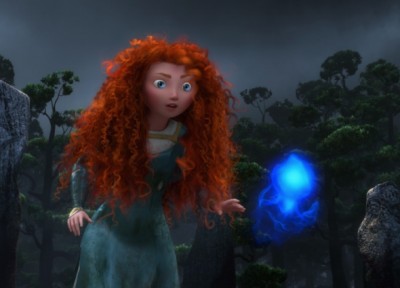 The film steals from a number of different other animation films. There’s the scene from Sword in the Stone where Wart chases an arrow into the woods. Merida does the same here until she meets up with a wood sprite. They steal from Miyazaki often in a very obvious fashion. Sprites taken from Princess Mononoke dominate woodland scenes and bring the Celtic magic to the forest.
The film steals from a number of different other animation films. There’s the scene from Sword in the Stone where Wart chases an arrow into the woods. Merida does the same here until she meets up with a wood sprite. They steal from Miyazaki often in a very obvious fashion. Sprites taken from Princess Mononoke dominate woodland scenes and bring the Celtic magic to the forest.
The real magic of the film comes when the mother is transformed, and they steal away to the woods to try to get the witch to change her spell. At one point the Pixar people have struck gold as they’ve dug into a real fairy tale that they’ve created. It’s right out of Russian or Germanic mythology, and it feels like real magic. It almost feels as though a tapestry has come to life. For this moment, the film truly soars.However, we’re very soon out of this magical moment and back to the world of the animated ordinary. The finale feels tagged onto what has been such a fine film through the first hour or so.
One would like to know what Brenda Chapman did before being replaced by Mark Andrews. I know that the film took place in snow throughout Chapman’s cut, and that was altered. I also know that the film’s title was originally The Bear and the Bow, which is a much more appropriate title. It hints at the notion of folk legend, and it has everything to do with the story. The title, Brave, makes no sense in the film I saw though there are a couple of lame attempts to justify it..
Generally, the acting – meaning the animation – in the film is better than recent other Pixar films, with the animation of the transformed Queen nothing short of wonderful. Merida’s horse is also solidly done with a strong and real character. They don’t try to anthropomorphize the character as was done in Tangled, and it’s a strong choice. The principals, Merida and her two parents, have been imbued with strong and complex character, and I enjoyed watching it develop. Whereas the father falls apart quickly, as I said, Merida’s personality continues to unfold right up to the end. The voice work is also brilliantly performed. Kelly McDonald is exceptional in her part as Merida as is Emma Thompson as the mother. Billy Connolly is also strong as the father, until the last third of the film when he can only read the lines he’s fed.
This is, as I said, my favorite Pixar film since Ratatouille, and I must admit after seeing recent films from them, I am surprised. It gives me a bit of hope. Congratulations to all who worked on it. CGI moves another step forward. I think Monsters 2 is up next. One step forward and . . .
Commentary &Daily post &SpornFilms 20 May 2012 06:26 am
Poe Props
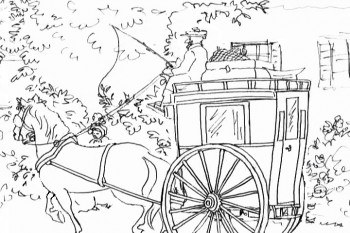 - There’s a certain difficulty in making a film about 1820-1850 as opposed to making it about 1850-1880. Things, in the New World, were being invented and didn’t look like any other eras. I suppose this is true about any era; there are always complications. New York City, for example, changed drastically in 1888, February 1888. Before that date the sky in the City was a mass of wires. One could barely see the sky for all the wires that were strung across the terrain. However, in February of 1888, there was a violent snow storm that knocked down all the wires, and that was the excuse the City enjoyed as they buried the wires underground. So after February of 1888, the sky was wide open, and the City had a major face lift. Photographs of the City from that period are remarkable.
- There’s a certain difficulty in making a film about 1820-1850 as opposed to making it about 1850-1880. Things, in the New World, were being invented and didn’t look like any other eras. I suppose this is true about any era; there are always complications. New York City, for example, changed drastically in 1888, February 1888. Before that date the sky in the City was a mass of wires. One could barely see the sky for all the wires that were strung across the terrain. However, in February of 1888, there was a violent snow storm that knocked down all the wires, and that was the excuse the City enjoyed as they buried the wires underground. So after February of 1888, the sky was wide open, and the City had a major face lift. Photographs of the City from that period are remarkable.
Well, the same was true of the props of the early part of the 19th Century. The first railroad train, for example, was engineered by Peter Cooper in 1829 and stretched from Baltimore to the village of Ellicott’s Mills thirteen miles west. The train, called the Tom Thumb, was modeled after a British locomotive. Since Edgar Allan Poe did a lot of traveling throughout his life, it was obvious to recreate such a vehicle and have our hero ride the rail – with an imagined orangutan, an animal that had just been discovered, and was seen to be the “missing link” they were searching for. Poe, of course, was aware of this news story, and incorporated an orangutan in the story, Murder in the Rue Morgue.
We did have to do some specific research for the train. We didn’t want something as early as the “Tom Thumb,” but we did want something a few years later.

Boarding the train.
It was also as likely for Poe to have traveled from New York to Maryland via many different other means of transportation. No doubt, part of the trip would be made via some short-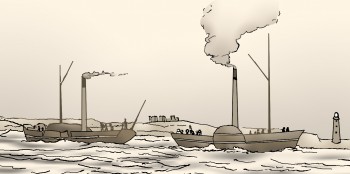 distanced local ferry. After all, it would have been faster to move over a body of water than over the land. In his lifetime, Poe lived in New York, Philadelphia, Baltimore, and Boston. To get from one place to another meant some significant travel as well as time and money. Edgar, Muddy (his Aunt/Mother-in-Law) and Virginia (his young wife) had to negotiate meticulous plans to travel. He wanted the least expensive route and the shortest travel time. Carriage, rail, horseback and ferry were the only real options open to them.
distanced local ferry. After all, it would have been faster to move over a body of water than over the land. In his lifetime, Poe lived in New York, Philadelphia, Baltimore, and Boston. To get from one place to another meant some significant travel as well as time and money. Edgar, Muddy (his Aunt/Mother-in-Law) and Virginia (his young wife) had to negotiate meticulous plans to travel. He wanted the least expensive route and the shortest travel time. Carriage, rail, horseback and ferry were the only real options open to them.

We also have a song in the show. Virginia was a singer. She died of complications after a blood vessel ruptured in her throat. There are songs that Edgar Allan Poe wrote for Virginia 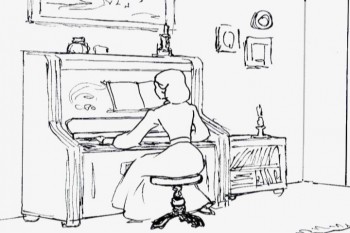 and his sister, Rosalie. In the film, Virginia sings one of those songs. Obviously, we had to know what kind of piano they would have had in their home – their poor and little home.
and his sister, Rosalie. In the film, Virginia sings one of those songs. Obviously, we had to know what kind of piano they would have had in their home – their poor and little home.
Pictured above is Rosalie’s piano gifted to Poe Cottage after her death in 1865. We imagined Virginia’s piano to be slightly different.
The good fortune that we do have is that Poe Cottage still stands as a tiny museum in the Fordham section of the Bronx. I grew up only a mile or two away from it, and I’ve passed it hundreds of times. Interestingly, I still haven’t visited it, though I certainly will before the film actually starts production. In fact, I expect to have a studio trip so we can all take it in together.

Poe Cottage in the Bronx.
There’s also the more elaborate Poe House down in Baltimore. Many artifacts decorate the house, and many of these were in Poe’s possession.
See Poestory.net.
See our Facebook page.
Check out our Indiegogo page and share it with friends of friends.
